| Please Sign the Guestbook | You can read previous entries by clicking here | Archived "Latest News" | back to the KOS Homepage |

Updated 31 December 2002.
31/12/02
Before setting off on this holiday to New Zealand we were told that we'd find
it rather like the England of 25 years ago, but staying as we are in the
southern suburbs of Auckland (population 1.2 million and rising exponentially)
with its crime rate rising at 13% a year and underlying racial tensions, it's
apparent that this part of the country has many of the problems currently
associated with any of the Worlds big cities. The rapid expansion of Auckland
is not constrained by space - there's plenty of it, seemingly unlimited, so
everyone seems to live in a detached bungalow with well stocked and tended
gardens; ideal Thrush country and the introduced populations of Blackbirds and
Song Thrushes take full advantage. Early morning song has declined since we
arrived but family parties of both species can now be seen throughout the area,
the bird baths are very popular in the afternoon as the temperature climbs
towards 30C. Other European introductions are also prospering with Redpolls,
Yellowhammers, Greenfinches, Goldfinches and House Sparrows all at (or above)
1977 UK levels! Skylarks are everywhere, even in the middle of building sites
we watched them bringing off one last brood before the fields vanished forever
under creeping suburbia. Driving across a high moorland region on the way to
Lake Taupo we stopped at a signposted scenic view point, miles from anywhere -
just a waterfall and a car park - but of course it seems that no matter where
you go in the World, where there's a car park there's a Chaffinch, and there he
was, a fine male bird who flew down to join us a and perched on the wing mirror
- chink, chink!!!! (Tony & Olwen Usher)
30/12/02 A small group of KOS members enjoyed an after Christmas walk. Starting at 10am from the Anderton Country Park car park the walk took us along the River Weaver and Witton Brook to Marbury Lane. We then walked up Marbury Lane to Marbury Country Park, where after a short interlude for some bird watching at the hide, we strolled through Big Wood and emerged on the banks of the Trent & Mersey canal. As the pictures show the walk had some tricky bits before we arrived back at the Anderton car park. No special birds were seen but we enjoyed close views of Siskin feeding on the Alders and the weather had been mild and dry. Now 12.30pm we completed our walk with lunch at the George & Dragon in Great Budworth.
 26/12/02 The following sightings were made by Peter Day (Voluntary
Rostherne Warden) in the morning.
26/12/02 The following sightings were made by Peter Day (Voluntary
Rostherne Warden) in the morning.
A bittern flew over the mere and a little later 500 lapwings were also sighted flying over the mere. A Green Woodpecker was calling all morning from Bongs Wood and several Redpoll were sighted on the trees at the mere edges.
26/12/02 Peter Hall, our local bird connoisseur at Toft, has seen over 200 Siskin in the Alders by Toft Pool and about 150 Lapwing on autumn sown wheat fields. The 10 Shoveler on Toft Pools were the first seen for a few months and far less than the normal 30 seen in previous years.
25/12/02 A stroll down Sudlow Lane, Knutsford by Derek & Jean - The weather was bright and mild as at 12 noon we departed from 2 Lilac Avenue. We had just turned into Sudlow Lane when we spotted a Kestrel. On turning the corner near Sudlow Farm we heard geese calling overhead and looked up to see 100 Pinkfoot flying south. Further down the lane we came across our first flock of about 90 Fieldfare and Redwings (predominantly Fieldfare) and then further flocks of about 40-50 birds with a final flock of about 40 Redwing on the ground. Our next sightings were a Buzzard flying out of a copse near the M6, a Grey Wagtail on a field of maize stubble, and two Great Spotted Woodpeckers. At Parkgate Farm a Pied Wagtail greeted us with a noisy call and we had great views of a Nuthatch at twenty feet. After sheltering from a heavy shower we continued to the brook and then turned round to retrace our steps. On the return journey we saw another Nuthatch, two Goldcrests in ivy on an old tree, a very loud Mistle Thrush flying overhead, and then to our surprise a Treecreeper low down in a Hawthorn hedge. Other birds encountered on our walk included various corvids, Woodpigeon, Blue Tit, Great Tit and Wrens but House Sparrow and Greenfinch were absent. We arrived home after our stroll of two hours having seen a good list of birds all within a mile or so of the house.
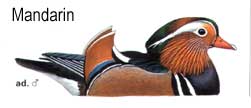 24/12/02 Seven Mandarin were seen in Tatton Park. They are
usually in the Higmere Plantation Rhododendron bushes at the water's edge and
are best viewed looking across the mere from Dog Wood. The numbers seem to
fluctuate from the original 14 seen in the autumn to 3 males reported on the
27th November and now 7 today. On the same day 3 Mandarins were seen at
Rostherne (2 males & 1 female).
24/12/02 Seven Mandarin were seen in Tatton Park. They are
usually in the Higmere Plantation Rhododendron bushes at the water's edge and
are best viewed looking across the mere from Dog Wood. The numbers seem to
fluctuate from the original 14 seen in the autumn to 3 males reported on the
27th November and now 7 today. On the same day 3 Mandarins were seen at
Rostherne (2 males & 1 female).
22/12/02 A male Hen Harrier being harassed by two crows flew across the mere and disappeared in the direction of Dunham Park. The starling roost in the reed beds has built up to about 10,000 birds. A Sparrow Hawk is often seen in the air as the Starlings fly round at dusk before settling.
20/12/02 Thanks to Nigel Troup for the following article on the difficulty in viewing Bitterns. Nigel spent some time at the viewing screen in Marbury Country Park.
I'm told that there
are two which have allegedly been showing in the reed beds opposite the
T.A.Coward hide all week. Apparently they were occasionally out on the ice when
the mere was frozen over earlier in the week. My
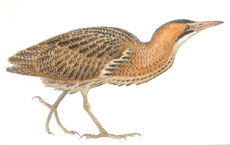 view, of just one of the birds, was far more cryptic. Three or
four observers were already hard at work behind the screen when I arrived on
Friday at 1.45pm and they were good enough to point me in the right direction.
Just as well as I could have sat there for a week and not found it. The bird
was completely invisible until it moved, when it magically took on form.
Fortunately it did quite a lot of preening in the half hour I watched it though
I would hesitate to say that I had good views. One guy with a huge zoom lens
had been there continuously since 9am and I doubt he got a good photo for his
troubles.
view, of just one of the birds, was far more cryptic. Three or
four observers were already hard at work behind the screen when I arrived on
Friday at 1.45pm and they were good enough to point me in the right direction.
Just as well as I could have sat there for a week and not found it. The bird
was completely invisible until it moved, when it magically took on form.
Fortunately it did quite a lot of preening in the half hour I watched it though
I would hesitate to say that I had good views. One guy with a huge zoom lens
had been there continuously since 9am and I doubt he got a good photo for his
troubles.
20/12/02 An afternoon in Marbury country park by Nigel Troup. A splendid afternoon's birding included a Little Stint busily feeding on the sandy banks where Kid Brook joins the mere, and a host of birds at Marbury No 1 tank (Haydn's Pool) which included Snipe, Teal, Shoveler, Gadwall, Shelduck, Goldeneye, Great Crested Grebe, Wigeon, and Lapwing.
20/12/02 Merlin near Glevehouse Farm. Mobberley.
20/12/02 A morning walk by Dave Clarke and John Heine over Richard Cleggs farm in Warburton produced a pair of Ravens, a Woodcock, 40 Meadow Pipits, 30-40 Skylarks and 3 Yellowhammers.
20/12/02 50 Redpolls were seen from the Observatory Hide at Rostherne feeding in Alders and Birch trees in Observatory Wood (to the right when viewing from the hide).
18/12/02 A morning visit to Rostherne found a Peregrine Falcon and two Buzzards. The Bittern has not been seen recently but will probably, if following past years, make more appearances over the winter.
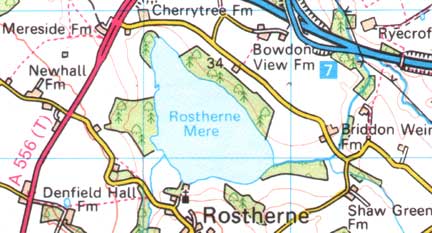 15/12/02 A juvenile Black Throated
Diver was discovered on Rostherne Mere National Nature Reserve on Saturday
afternoon. It was only definitely identified this morning when the light was
better. Normally located in the middle of the mere it can be seen from the
Rostherne hide or from behind the church.
15/12/02 A juvenile Black Throated
Diver was discovered on Rostherne Mere National Nature Reserve on Saturday
afternoon. It was only definitely identified this morning when the light was
better. Normally located in the middle of the mere it can be seen from the
Rostherne hide or from behind the church.
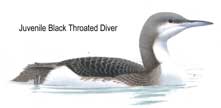
13/12/02 The Christmas Party was enjoyed by all with excellent food from Jill and helpers, games from John and Sheila, Raffle and Bring & Buy organised by Roy, and baked potatoes courtesy of Sue & Terry. Tickets were again only £4.50 and a profit of £62 will help the society pay for speakers in 2003. Some of the cast of this extravaganza can be seen in the Photo Gallery.
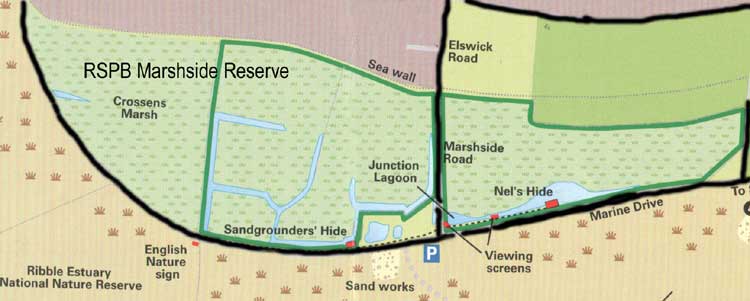
At 10am on Sunday 8th December we arrived at the RSPB
Marshside Reserve at Southport. There are rare days at Marshside where it
is windless and warm but the KOS members are a hardy lot and a temperature of 4
°c with a stiff easterly wind was just fine. We left
the car park next to the Sand Works and crossed Marine Drive to one of the new
viewing screens. The marsh was full of ducks and though Wigeon were by
far the most numerous there
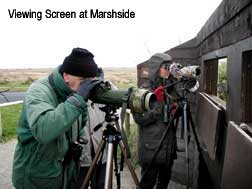 were good numbers of Teal, Pintail,
Shoveler and Mallard. Waders were represented by a large flock of Black Tailed
Godwits but other waders were scarce and there was not a Golden Plover in
sight. After 30 minutes at the
were good numbers of Teal, Pintail,
Shoveler and Mallard. Waders were represented by a large flock of Black Tailed
Godwits but other waders were scarce and there was not a Golden Plover in
sight. After 30 minutes at the
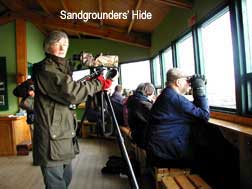 viewing screen we decided that we had earned some
warmth and moved to the Sandgrounders Hide. With no windows open it
was warm and windless and after scopes were set up it was only a few minutes
before our first bird of prey was spotted, a Merlin on the ground. Geese
numbers were low, plenty of Greylags but only a sprinkling of Pinkfeet. The odd
Redshank was present but again no Golden Plover. Another birdwatcher told
us that he had seen only about a dozen Golden Plover far to our left on
Crossens Marsh but he also mentioned that he had just seen Marsh Harrier on the
National Nature Reserve run by English Nature. Out into the cold again as
we walked along Marine Drive in search of the Marsh Harrier. As we looked
seawards groups of Curlew flew across the marsh and then we spotted our second
bird of prey, a Kestrel sitting on a post. On examining the other fence posts
we then discovered a Peregrine Falcon. It took another 30 minutes of
biting cold before we at last spied the Marsh Harrier which rose about 20 feet
into the air and settled back onto the ground. Now 12.15pm and with the
cold giving us a good appetite it was time to return to the cars and make our
way to Martin Mere Wildfowl Trust centre where sandwiches could be eaten in
comfort.
viewing screen we decided that we had earned some
warmth and moved to the Sandgrounders Hide. With no windows open it
was warm and windless and after scopes were set up it was only a few minutes
before our first bird of prey was spotted, a Merlin on the ground. Geese
numbers were low, plenty of Greylags but only a sprinkling of Pinkfeet. The odd
Redshank was present but again no Golden Plover. Another birdwatcher told
us that he had seen only about a dozen Golden Plover far to our left on
Crossens Marsh but he also mentioned that he had just seen Marsh Harrier on the
National Nature Reserve run by English Nature. Out into the cold again as
we walked along Marine Drive in search of the Marsh Harrier. As we looked
seawards groups of Curlew flew across the marsh and then we spotted our second
bird of prey, a Kestrel sitting on a post. On examining the other fence posts
we then discovered a Peregrine Falcon. It took another 30 minutes of
biting cold before we at last spied the Marsh Harrier which rose about 20 feet
into the air and settled back onto the ground. Now 12.15pm and with the
cold giving us a good appetite it was time to return to the cars and make our
way to Martin Mere Wildfowl Trust centre where sandwiches could be eaten in
comfort.
On arrival at Martin Mere we were astonished to find the car park
overflowing. A crafts fair was being held in the main building and
entrance fees had been waived for the day. Inside, despite the crowds, we
were able to get seats by the viewing window. After a leisurely lunch,
with some of our members buying hot soup in the restaurant, we walked to the
Swan Link Hide where masses of Whooper Swans crowded the banks. As we
scanned round
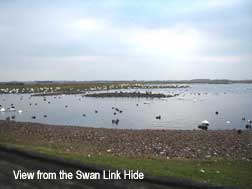 the pool edges we picked up large numbers of
Ruff. Using scopes we almost missed three Ruff which were amongst
Greylags only a few feet in front of us. Though we searched all over we
could not find any Bewick Swans. Though numbers here are usually low this was a
little strange. Another birdwatcher then told us that there was only one here
and he had not found it yet. As we walked towards the North West Water
Hide we met a number of birdwatchers along the path looking for a Firecrest
which had been last spotted only an hour earlier on an Ivy covered tree by the
side of the path. We kept our eyes open and saw numbers of Siskin, Long
Tailed
the pool edges we picked up large numbers of
Ruff. Using scopes we almost missed three Ruff which were amongst
Greylags only a few feet in front of us. Though we searched all over we
could not find any Bewick Swans. Though numbers here are usually low this was a
little strange. Another birdwatcher then told us that there was only one here
and he had not found it yet. As we walked towards the North West Water
Hide we met a number of birdwatchers along the path looking for a Firecrest
which had been last spotted only an hour earlier on an Ivy covered tree by the
side of the path. We kept our eyes open and saw numbers of Siskin, Long
Tailed
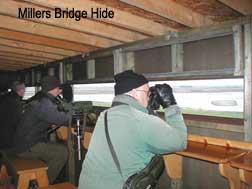 Tits, and Goldfinches but no Firecrest. On
reaching the North West Water Hide we found it completely empty and this was
despite the masses of people at Martin Mere today. We had to admit it was
a little cold looking out of the top windows in the hide but Barnacle Geese in
a nearby field, a Buzzard sitting on a fence post, and good views of a
Peregrine dashing across the water made it worthwhile. We had just enough
time to get to Miller’s Bridge Hide. On the way there was no
Firecrest but a Sparrowhawk flew overhead giving us our 6th bird of
prey for the day. Nothing new was seen from Miller’s Bridge Hide and
despite a different viewpoint the elusive Bewick Swan was nowhere to be
seen. Now 3pm and already becoming dark it was time to leave Martin Mere
and make our way home. An excellent days bird watching.
Tits, and Goldfinches but no Firecrest. On
reaching the North West Water Hide we found it completely empty and this was
despite the masses of people at Martin Mere today. We had to admit it was
a little cold looking out of the top windows in the hide but Barnacle Geese in
a nearby field, a Buzzard sitting on a fence post, and good views of a
Peregrine dashing across the water made it worthwhile. We had just enough
time to get to Miller’s Bridge Hide. On the way there was no
Firecrest but a Sparrowhawk flew overhead giving us our 6th bird of
prey for the day. Nothing new was seen from Miller’s Bridge Hide and
despite a different viewpoint the elusive Bewick Swan was nowhere to be
seen. Now 3pm and already becoming dark it was time to leave Martin Mere
and make our way home. An excellent days bird watching.
04/12/02 The continuing spell of mild weather has prompted one or two species into song, especially the Thrushes. In Tatton both Song and Mistle have been tuning up and yesterday at the Anderton reserve we listened to the song of a visiting Redwing, not the full version, but the subtle sub-song often heard in the Spring just before they leave us for the north. Haydn's pool was quiet, just a couple of Dabchicks, small flocks of Mallard and Gadwall plus a flock of around 50 Teal, whilst in the surrounding trees and shrubbery we noted plenty of Thrushes and Siskins together with a small flock of 7 Lesser Redpolls. Also here we again came across a group of 4 Bullfinches - 3 males and a female - as usual they were very wary, but we moved back a few yards and we had excellent views as they skillfully extracted the seeds from the fleshy fruit of the Guelder Rose Viburnam opulus. The mid-range weather forecast is for the onset of much colder weather with easterly winds sweeping down from the Urals - excellent! plenty of ice and snow and the prospect of a white Christmas! Not for me though, because the Little(ish) Lady and I are flying out to the Colonies for an inspection tour and will be spending five weeks in New Zealand before returning in early January, just in time to organise the 2003 KOS Sand Martin Competition!. Fear not though, the baked potatoes for the Christmas Party have been organised and are in the safe hands of Terry and Sue! The website has been left in the equally safe hands of John "my hard drive has crashed again" Somerville who will update it on a regular basis. So please feel free to check in from time to time for news of the Christmas Party, the annual Christmas walk and the droves of rarities forced across from the Continent during the coming Big Freeze. John would appreciate any records from the area for inclusion in this section of the Website and can be contacted by e-mail. So have a peaceful Christmas and New Year, thanks to all those who visit our site on regular basis and I'll see you in January!
27/11/02 It's just like old times again in Tatton! Let's
hope that the recent renewal of interest in the park is maintained, it's been
"underwatched" ever since people started to go elsewhere during the
foot & mouth crisis last year. The wintering Stonechat has been joined by a
second bird, both were seen last Friday (22nd) by Bob Groom in the reeds round
Melchett Mere, earlier Bob had walked over towards the Mill Pool where he had
Kestrel, Buzzard, Peregrine and Red Kite all in view at the same time!
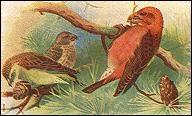 The Kite was still there today
(Paul Leigh), Paul also put up a Jack Snipe from the Melchett reedbed. We
enjoyed a vintage day in the park on Tuesday, beginning on Knutsford Moor where
a flock of c. 40 Siskins feeding in the Alders also contained a couple of
Lesser Redpolls, further along in Dog Wood foraging Chaffinches feeding under
the Beech trees were accompanied by at least 2 Bramblings, their white rumps
clearly visible as they sought shelter in the Rhododendrons as we approached.
Across in Higmere Plantation we could just make out 3 male Mandarins amongst
the tangle of roots, the remnants of the flock of 15 counted earlier in the
Autumn; how can such a striking bird remain so well hidden! Things got even
better at Melchett as we searched for the Stonechats, first an immaculate
female Goosander in the center of the mere was a reminder of years gone by when
a good flock often built up here during the Winter months, but then the stars
of the show appeared from the west, landing at the top of an oak tree
immediately in front of us - 7 Crossbills including at least two handsome male
birds that perched obligingly for a couple of minutes right at the top of the
tree before they flew off east directly over where we were stood - their
characteristic calls clearly heard as they went - needless to say I'd left my
new camcorder at home!
The Kite was still there today
(Paul Leigh), Paul also put up a Jack Snipe from the Melchett reedbed. We
enjoyed a vintage day in the park on Tuesday, beginning on Knutsford Moor where
a flock of c. 40 Siskins feeding in the Alders also contained a couple of
Lesser Redpolls, further along in Dog Wood foraging Chaffinches feeding under
the Beech trees were accompanied by at least 2 Bramblings, their white rumps
clearly visible as they sought shelter in the Rhododendrons as we approached.
Across in Higmere Plantation we could just make out 3 male Mandarins amongst
the tangle of roots, the remnants of the flock of 15 counted earlier in the
Autumn; how can such a striking bird remain so well hidden! Things got even
better at Melchett as we searched for the Stonechats, first an immaculate
female Goosander in the center of the mere was a reminder of years gone by when
a good flock often built up here during the Winter months, but then the stars
of the show appeared from the west, landing at the top of an oak tree
immediately in front of us - 7 Crossbills including at least two handsome male
birds that perched obligingly for a couple of minutes right at the top of the
tree before they flew off east directly over where we were stood - their
characteristic calls clearly heard as they went - needless to say I'd left my
new camcorder at home!
21/11/02 Fieldfares appear to be in relatively short supply this Autumn, although we noted a flock of around 60 birds on Tuesday during a walk round Budworth Mere. Redwings arrived early, 3 birds were seen on the 20th of September in Toft and since then they have been widely distributed throughout the area. Many observers have commented on the number of Blackbirds around this year and, although they are never as common in Winter as Redwings and Fieldfares, the hawthorn hedges are full of them taking advantage of a super crop of berries; ringing recoveries show that most will be visitors from the Continent. Derek and Jean discovered a female / immature Stonechat on a recent visit to Tatton, 2 birds were present for most of last Winter favouring the old bathing area, where they were often to be seen in the juncus reedbed. Interestingly the preferred habitat for the "Siberian" Stonechat (s.t. maura) according to BWP is " moist meadows with plenty of grass, tall herbage and marshes with shrubs" there was an influx of these visitors from the east at the end of last year, but we never got good enough views of the Tatton birds to establish their true identity.
12/11/02 One of the abiding memories of Bill Mulligan was his eternal optimism when it came to the weather - "Come on he'd say" as he strode off into the mist on some Welsh hillside "it never rains all day !" - he was right of course - it rarely does! We were reminded of his philosophy on Sunday as a small (but select!!) group of us huddled in the pouring rain on the forecourt of Knutsford Sessions House discussing various alternatives to our "official" November field trip to Wigan Flashes, preferably somewhere with hides! Eventually we decided on the Mulligan approach and floated off up the M6 in a northerly direction for a look at these interesting subsidence "flashes" that we'd not visited as a group before, but one or two people had previously explored individually. The decision to travel to Wigan was a good one, the rain stopped after half an hour, and shortly afterwards out came the sun! During the week Bearded Tits had been seen in the reeds on the shore of Scotsman's flash but had moved on by Sunday, Water Rails could be heard calling from deep in the undergrowth whilst overhead in the phragmites reedbed Reed Buntings flitted in and out of view. Walking in a northerly direction, along a disused railway line, we arrive at a splendid view-point where we were afforded good views across both Scotsman's and Pearson's flashes. On the former were Shoveler, Pochard, Tufted Duck, Great Crested Grebes and a single male Goosander whilst additionally over on Pearson's we enjoyed super views of Gadwall, Ruddy Duck, Goldeneye and a large flock of Wigeon in immaculate plumage. Retracing our steps we continued along the canal bank as far as Horrock's flash, home to a noisy Green Woodpecker and a further group of ducks including here a large flock of Teal. Heading back to the cars we came across a feeding station where a peanut feeder was attracting Greenfinch and Dunnock plus Blue, Great and Willow Tit, two of the latter, readily identifiable by their characteristic buzzing "tchay tchay tcahy" calls, by now the sun was getting quite low in the sky and because it was positioned behind us we were able to study the plumages of the Willow Tits in great detail - ID books in hand!
07/11/02 Parkgate on
the Wirral looks just like many other seaside towns, with a fine sandstone sea
wall protecting the esplanade and the town’s long single row of buildings
from the elements. Indeed it used to be the main point of departure for ships
sailing across the Irish Sea from England to Dublin and at the end of the
18th century ships of 350 tons could reach the Parkgate quays.
Unfortunately for the town man-made and natural changes during the next 200
years caused the approach to the quays to become silted up and un-navigable,
and today Parkgate looks out over thousands of acres of salt marsh stretching
out towards the distant Welsh shore. The habitat created has proved to be very
beneficial to the wildlife and, especially during the winter months, is home to
thousands of birds feeding on seeds, mammals or each other! Along with
literally 100’s of other birders we visited Parkgate this week during one
of the occasional high tides when the sea once again approached the quayside
and the whole area area became alive with birds and small mammals as they were
forced from the cover of the vegetation by the advancing water. Of the
passerines Skylarks and Linnets were the most prominent, it’s difficult to
believe that both have declined so much of late, there seemed to be huge
numbers about on Tuesday. Out on the open water we noted good numbers of
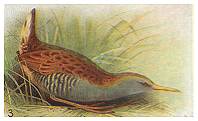 waterfowl, Mallard, Teal and especially Wigeon were much in
evidence, whilst overhead were the waders; Redshank, Curlew, Black-tailed
Godwit and Snipe – we saw only Common but others reported one or two Jack
Snipe amongst them. Of the birds of prey we saw Kestrel, Sparrowhawk, 2
Short-eared Owls and 2 Merlins that gave the watching crowd such exciting views
as they hunted low over the marsh, scattering the small birds in all
directions. As usual Grey Herons were feasting on the wintering Water Rails
that rely so much on dense cover for safety, but prove to be easy prey when
they find themselves out in the open – it takes a Heron a long time to get
a Water Rail down it’s throat – whole, not a pretty
sight!
waterfowl, Mallard, Teal and especially Wigeon were much in
evidence, whilst overhead were the waders; Redshank, Curlew, Black-tailed
Godwit and Snipe – we saw only Common but others reported one or two Jack
Snipe amongst them. Of the birds of prey we saw Kestrel, Sparrowhawk, 2
Short-eared Owls and 2 Merlins that gave the watching crowd such exciting views
as they hunted low over the marsh, scattering the small birds in all
directions. As usual Grey Herons were feasting on the wintering Water Rails
that rely so much on dense cover for safety, but prove to be easy prey when
they find themselves out in the open – it takes a Heron a long time to get
a Water Rail down it’s throat – whole, not a pretty
sight!
31/10/02 The weekend gales were at their fiercest well to
the south of us, the strongest local gust, recorded at nearby Jodrell Bank, was
a modest 73 mph. One or two old Beeches were blown over in
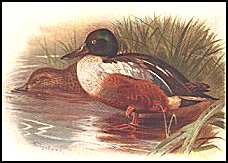 Tatton, but apart from these,
damage was limited to a few Oaks with their branches hanging off; nothing like
the gales of the mid-1980's or the big one on the first of January 1976. The
Mandarins have returned to Tatton, we counted 15 under the overhanging branches
of the Higmere Plantation opposite Dog Wood, there could have been more as they
were quite well hidden. Further up the main mere we noted 3 imm/female
Goldeneye, 10 Wigeon (3 ad. males) and no less than 52 Shoveler - I remember a
flock of 75 of the latter, counted some years ago in September, but 52 is
probably the biggest recent gathering. I don't think there are currently any
regular wildfowl counts in the park, it's a rewarding occupation and with the
computer programs now available some pretty impressive graphs and charts can be
produced to enhance your local bird report or website - perhaps this is a job
for our Tuesday group!
Tatton, but apart from these,
damage was limited to a few Oaks with their branches hanging off; nothing like
the gales of the mid-1980's or the big one on the first of January 1976. The
Mandarins have returned to Tatton, we counted 15 under the overhanging branches
of the Higmere Plantation opposite Dog Wood, there could have been more as they
were quite well hidden. Further up the main mere we noted 3 imm/female
Goldeneye, 10 Wigeon (3 ad. males) and no less than 52 Shoveler - I remember a
flock of 75 of the latter, counted some years ago in September, but 52 is
probably the biggest recent gathering. I don't think there are currently any
regular wildfowl counts in the park, it's a rewarding occupation and with the
computer programs now available some pretty impressive graphs and charts can be
produced to enhance your local bird report or website - perhaps this is a job
for our Tuesday group!
23/10/02 A flurry of first records over the past few days plus what was probably a last glimpse until next Spring of one of our best-loved birds. In Toft, on the 17th, Pete Hall had the first Brambling of the Autumn, 2 days later than last year's first bird, this was closely followed on the next day by a Fieldfare, again just 2 days after 2001's earliest. Pete noted the first flock of Siskins yesterday when a group of 10 were seen, we had a single bird over Tatton on the 19th, but this is a species that can now be met with in any month of the year although it's only during the Winter months that substantial flocks build up ; peaking in early Spring when birds that have wintered further south join up with those that have remained with us during the cold weather. At Rostherne 2 Goldeneye were feeding in the shallows but there was no sign of the Goshawk that was mentioned in the observatory log earlier in the week, this is presumably the same bird that has been seen recently at Tatton. As we were watching a Buzzard flying over Harper's Bank wood a small bird could be seen doing its best to pester it, the raptor remained quite unconcerned by the aggressor which turned out to be a Swallow, rather a late sighting for this species although the latest record for the County is 26th of December : if it had stayed in the area for a few more days would it also have been the earliest bird?!
16/10/02 Although the predominant colour of our Cheshire countryside remains green there's now more gold and yellow appearing as the Autumn conditions begin to take over. We had a lot of rain over the weekend combined with gale force winds, unusually these blew in from the east - normally our strongest winds arrive from the west. A few Skylarks were noted passing over Mobberley on Sunday, together with an increasing number of Redwings, there were 30 in one flock. From Pavement Lane 3 House Martins could be seen over the Longridge Estate while further up the road at Pavement Lane Farm the last Swallows only left in the middle of last week, they are rather late this year, the Rostherne logbook mentions a flock of 10 seen on Tuesday (13th). Fun and games over Mobberley early this morning, first a rare visitor, a Peregrine Falcon, passed over the village in a north-easterly direction, then at 8:10 am my attention was drawn to what I took to be a flock of Gulls circling in a disorganised manner in the direction of the Station. They turned out to be a flock of around 80 Pink-footed Geese that had been scattered by an aircraft on the "approach" to Manchester Airport, 4 birds had ignored the danger and were continuing on their way, the remainder quickly regained their characteristic "V" formation and dashed across the flightpath just in front of an approaching green giant from Islamabad! These planes are LOW at this point, last night I was listening on my scanner to the radio traffic between the control tower and landing aircraft, the pilots were reporting fireworks being fired at them from a location about 1.5 miles south - west of the new runway, have a look on your map! Oh yes - enjoy your flight!!
09/10/02 Our "Indian Summer" continues, albeit a little cooler today as the wind once again swings round to the north-east and increases in strength. Pete Hall has recorded the arrival of more Redwings in Toft, together with a strong passage of Skylarks earlier in the week, additionally Pete's last brood of House Martins have fledged and will no doubt be soon on their way south. We saw a flock of a dozen House Martins over the Anderton Reserve at Northwich on Tuesday morning, Kingfishers have returned to the Reserve for the Winter and we saw one bird perched on a branch overhanging the small feeder stream close to where it enters Witton Brook . Nearby a pair of Bullfinches showed well as they fed on Hawthorn berries in a bush close to the path, there's an abundance of these berries this year: also both Rowan and Elder have produced excellent crops, the latter have mostly gone, devoured by the local Starlings whose droppings bear witness to their partiality for this particular food!
04/10/02 The A.W. Boyd Memorial
Observatory at the Rostherne National Nature Reserve was opened in 1962 three
years after Boyd's death, it proved to be very popular, so much so that in 1976
an extension was built, doubling the viewing capacity.
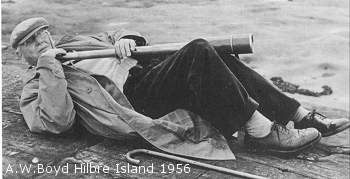 Predictably it was
always at its busiest during the weekend, in the early 1970's before the advent
of "Bird Lines" and pagers, as the gulls were pouring into the Winter
roost many of the "youngsters" would arrive at the Observatory to
swap the latest news - Adam Davison, Paul Ellison, Alan Roberts and of course
Jonathan Guest complete with Hardyesque army great-coat, astride a Honda 50
moped spring to mind. It was normally standing room only on a Sunday morning,
especially when there was a duck count on and T. Hedley Bell and L.P. Samuels
would make their monthly appearance to walk round the margins of the mere,
flushing the wildfowl as they went so that the minions back in the Observatory
could establish the current population. The then Warden Tom Wall introduced us
one morning to a rather special visitor
Charles
Tunnicliffe no less, a charming man who sketched a Cormorant and added a
few comments amongst the graffiti and general insults on the inside of the back
cover of the log-book, what a splendid memento - I wonder if it's still around?
We paid a long overdue visit to the Rostherne Observatory on Tuesday morning,
it's changed little since those early days, black and white photos of
Coward, Boyd and Bill Mulligan look down from the walls, a
constant reminder of our own mortality and still so peaceful, despite its
proximity to the A556 and the M56. Recent counts show a slow build-up in
wildfowl numbers plus the earliest ever record for Bittern, perhaps of British
origin rather than from the continent, which is where these birds normally come
from. We had little of note, fine views of a Mistle Thrush in song across in
the split Lime, Buzzards over Mere Covert and a Sparrowhawk only inches from us
as it scattered the Chaffinches and Nuthatches feeding on the bird table. A
typical morning at Rostherne, yes it's got a big species list to its name, but
it's something that's built up slowly over many years - it's definitely not a
place for twitchers! Perhaps, as the oil runs out and the internet looses its
fascination, people will learn again how to communicate face to face and
Rostherne will re-gain its popularity.
Predictably it was
always at its busiest during the weekend, in the early 1970's before the advent
of "Bird Lines" and pagers, as the gulls were pouring into the Winter
roost many of the "youngsters" would arrive at the Observatory to
swap the latest news - Adam Davison, Paul Ellison, Alan Roberts and of course
Jonathan Guest complete with Hardyesque army great-coat, astride a Honda 50
moped spring to mind. It was normally standing room only on a Sunday morning,
especially when there was a duck count on and T. Hedley Bell and L.P. Samuels
would make their monthly appearance to walk round the margins of the mere,
flushing the wildfowl as they went so that the minions back in the Observatory
could establish the current population. The then Warden Tom Wall introduced us
one morning to a rather special visitor
Charles
Tunnicliffe no less, a charming man who sketched a Cormorant and added a
few comments amongst the graffiti and general insults on the inside of the back
cover of the log-book, what a splendid memento - I wonder if it's still around?
We paid a long overdue visit to the Rostherne Observatory on Tuesday morning,
it's changed little since those early days, black and white photos of
Coward, Boyd and Bill Mulligan look down from the walls, a
constant reminder of our own mortality and still so peaceful, despite its
proximity to the A556 and the M56. Recent counts show a slow build-up in
wildfowl numbers plus the earliest ever record for Bittern, perhaps of British
origin rather than from the continent, which is where these birds normally come
from. We had little of note, fine views of a Mistle Thrush in song across in
the split Lime, Buzzards over Mere Covert and a Sparrowhawk only inches from us
as it scattered the Chaffinches and Nuthatches feeding on the bird table. A
typical morning at Rostherne, yes it's got a big species list to its name, but
it's something that's built up slowly over many years - it's definitely not a
place for twitchers! Perhaps, as the oil runs out and the internet looses its
fascination, people will learn again how to communicate face to face and
Rostherne will re-gain its popularity.
The Observatory is manned every Wednesday from 10am. non-permit holders are welcome. (£1)
29/09/02 An encouraging turnout on Friday at the new venue for the first Indoor meeting of the season; by tradition we once again welcomed Gordon Yates who proved to be in effervescent form as he guided us enthusiastically round his beloved Islay. The Red Kite is still around, with reports from both Rostherne and Tatton during the last week, there's no reason why it shouldn't remain with us for some time the Deer Park in Tatton is an ideal place for it to spend the Winter, closed to the public and isolated with an abundance of rabbits. We failed to find it on a mid-week visit to the park but there were plenty of other interesting species around as our Summer birds depart and are replaced with our friends from the north, Meadow Pipits were much in evidence between the Mill Pool and the Old Hall, with the occasional Skylark passing over in a South - westerly direction. 15 Greylags flew off Melchett Mere as we approached, a very early record of Pink-footed Geese has been received, perhaps these were what were seen - although the Pinkfeet at Martin's Mere have begun to return early, the first birds were seen on the 9th of September. A few Swallows were still passing through, dribs and drabs all morning, whilst over the main Mere an Arctic Tern had lingered for some days and gave excellent views as it hawked for insects low over the water only a few yards from where we stood.
20/09/02 After an unusually quiet period over the last few weeks, a sudden flurry of activity as we progress into the Autumn. News first from Tatton where a Red Kite appeared yesterday (19th.) it was favouring the Deer Park in the area beyond the Mill Pool, the same location as the last bird that stayed for 18 months in 1994/95. That particular individual sported coloured wing tags, enabling it to be identified as a juvenile bird from mid - Wales ; Darren Morris had good views of the latest visitor and saw no evidence of tags or leg rings. Some interesting records from Toft where Pete Hall reports the last brood of Swallows fledging on the 18th - most of our Mobberley birds have now left and been "replaced" by the first of the season's Meadow Pipits. Pete also noted the Pipits, from the 14th along with Song Thrushes since Tuesday (17th) but a record of 3 Redwings today (20th) is exceptionally early, perhaps they've been encouraged on their way by the north-easterly winds we've been experiencing for the past 2 weeks.
17/09/02 Another very enjoyable trip on Sunday when we
made our way west on the A55 to Llandudno and the Great Orme. On this occasion
we drove round the Marine Drive and began our walk from the car park of the "Rest and be Thankful"
cafe which is the highest point reached on the perimeter road, but about 100'
lower than the actual summit.
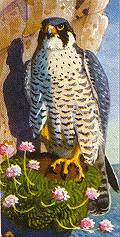 The route we took is
relatively easy going and avoids some of the more extreme gradients that exist
on the Orme - first we crossed the "limestone pavement" area ; quiet
at this time of year with Raven, Buzzard and family parties of Stonechats
practically all we saw (later in the day though, other birders were lucky
enough to discover a migrating Dotterel, which must have made a fine sight in
that wild landscape). Reaching the area above St. Tudno's church we zig-zagged
down the road, past the Old Rectory Tea Gardens and down to the Marine Drive
once again, climbing up a gentle slope on our way back to the car park. The
great seabird colonies were deserted, but we did see a few Gannets out towards
the horizon, Fulmars sweeping alongside the cliffs and an obliging Peregrine
Falcon that perched long enough for 'scopes to be erected and gave nice views
against a backdrop of blue sky and the Irish Sea. We lunched on the cliff top
looking over towards Anglesey, 3 Wheatears joined us for a short time, whilst
over the sea a large flock of 60 Common Scoters flew below, low over the sea
and on round the headland. In contrast to the tranquility to be found on the
Orme the RSPB Reserve at Conway was packed out with visitors, many trying out
the selection of binoculars and telescopes that had been set up for the
afternoon. There were plenty of birds on show, 2 juvenile Curlew Sandpipers
proved very obliging in front of the Information Center and a normally skulking
Water Rail appeared from time to time feeding on crumbs falling from a bird
feeder. A good selection of water birds on the pools - Coot, Moorhen, Mallard,
Shoveler, Teal, Gadwall and over 100 Wigeon now coming out of eclipse plumage
and looking quite presentable. Conway is definitely a mid-week reserve ; the
Great Orme is a delight anytime, one of the UK's best kept secrets.
The route we took is
relatively easy going and avoids some of the more extreme gradients that exist
on the Orme - first we crossed the "limestone pavement" area ; quiet
at this time of year with Raven, Buzzard and family parties of Stonechats
practically all we saw (later in the day though, other birders were lucky
enough to discover a migrating Dotterel, which must have made a fine sight in
that wild landscape). Reaching the area above St. Tudno's church we zig-zagged
down the road, past the Old Rectory Tea Gardens and down to the Marine Drive
once again, climbing up a gentle slope on our way back to the car park. The
great seabird colonies were deserted, but we did see a few Gannets out towards
the horizon, Fulmars sweeping alongside the cliffs and an obliging Peregrine
Falcon that perched long enough for 'scopes to be erected and gave nice views
against a backdrop of blue sky and the Irish Sea. We lunched on the cliff top
looking over towards Anglesey, 3 Wheatears joined us for a short time, whilst
over the sea a large flock of 60 Common Scoters flew below, low over the sea
and on round the headland. In contrast to the tranquility to be found on the
Orme the RSPB Reserve at Conway was packed out with visitors, many trying out
the selection of binoculars and telescopes that had been set up for the
afternoon. There were plenty of birds on show, 2 juvenile Curlew Sandpipers
proved very obliging in front of the Information Center and a normally skulking
Water Rail appeared from time to time feeding on crumbs falling from a bird
feeder. A good selection of water birds on the pools - Coot, Moorhen, Mallard,
Shoveler, Teal, Gadwall and over 100 Wigeon now coming out of eclipse plumage
and looking quite presentable. Conway is definitely a mid-week reserve ; the
Great Orme is a delight anytime, one of the UK's best kept secrets.
13/09/02 Excellent weather at the moment to end the Summer, clear blue skies and the mercury up as high as 24ºC during the day but dropping to a chilly 12ºC at night. Thermals generated by the heat are much to the liking of our local raptors, 9 Buzzards were watched together over Tatton Park and in Mobberley three separate sightings this week of Hobbies, 2 birds on each occasion, tonight's pair were chasing hirrundines high over Spring Wood and the Longridge estate; records of Hobby in Cheshire are increasing year on year, one or two nest sites are known but it's probable that many more are going unnoticed
09/09/02 There are many thousands of marl pits scattered throughout the County of Cheshire, a book I was reading the other day included an article about these pits - they date back to at least the mid - 17th Century. Of more recent origin and much more substantial are the sand pits that have sprung up since the 1930's to supply the glass making factories of St. Helens and the foundries of the West Midlands with the highest grade of sand to be used in the production of their premier products. Eventually when extraction is complete these sites are landscaped and become very attractive habitats for a wide range of wildlife, Sand Martins nest extensively in the steep banks even before extraction ceases and Little Ringed Plovers find them irresistible in the period before emergent willow, birch and eventually oak take over. The depth of these workings can be considerable, well below the natural water table and as a consequence large stretches of water are created, these attract nesting Ducks and Grebes in Spring and Summer plus even more waterfowl during the Winter months. Some such as Shakerley Mere are open to the public but most are privately owned, access being granted to fishing clubs who presumably pay through the nose for this privilege. A couple of well hidden examples lie alongside the A50 at Allostock across the road from Dove Mere and one of these, Newplatt Lake and the surrounding woodland - together covering 84 acres is for sale by private tender, we popped in last week whilst travelling south for a long overdue visit to Sandbatch Flashes. It's a most attractive place - conifers have been planted round the perimeter, they were proving attractive to Nuthatches and Goldcrests, whilst a Chiffchaff sang from the undergrowth between there and the lake. On the water itself we noted Great Crested Grebes and at least 15 Little Grebes together with Coot, Moorhen, Tufted Duck and Pochard, Curlews were much in evidence in the surrounding fields, we counted around 40 birds, the forerunners of a larger flock that builds up in the Autumn and will Winter in the area.
01/09/02 September already, the nights are drawing in rapidly and the weather forecast for the coming week mentions for the first time the possibility of frost! The Swallows don't need any help from us, they know just where Nature's calendar is up to and for the past 10 days they've been gathering in large numbers early each morning on the phone lines along Pavement Lane in Mobberley - youngsters and adults seemingly in animated conversation discussing the best time to begin heading south - that will be in two or three weeks, the majority are gone by the third week of the month. Our Sand Martins will be on their way around now but House Martins seem a little more hardy and they'll be with us until mid-October or even into early November; in 1978 a pair were still feeding young on the 20th October along King Street in the center of Knutsford.
22/08/02 A quiet morning in Tatton on Tuesday, but dry
and warm for a change with an interesting variety of late Summer flowers for
use on John's impressive new
Cheshire flowers
website that continues to expand but has yet to incorporate the search
facility as specified in the original challenge!!!
 The only
song heard was from a solitary Chiffchaff and a couple of Stock Doves in Dog
Wood, although it might be stretching things somewhat to describe the
Dove's call as a song it serves the purpose
and has the desired effect! Nuthatches and Treecreepers were quite vocal, as
were the young Great Crested Grebes on the main Mere, they appear to be
enjoying a good breeding season - four families were present. These birds have
a long season, Derek and Jean saw a pair recently with "back riding"
youngsters - seeking safety on the backs of the parent birds. Nest building on
Tatton has been seen from mid-February, with young before the end of March
right through to the late Summer - incubation has been noted in previous years
as late as September.
The only
song heard was from a solitary Chiffchaff and a couple of Stock Doves in Dog
Wood, although it might be stretching things somewhat to describe the
Dove's call as a song it serves the purpose
and has the desired effect! Nuthatches and Treecreepers were quite vocal, as
were the young Great Crested Grebes on the main Mere, they appear to be
enjoying a good breeding season - four families were present. These birds have
a long season, Derek and Jean saw a pair recently with "back riding"
youngsters - seeking safety on the backs of the parent birds. Nest building on
Tatton has been seen from mid-February, with young before the end of March
right through to the late Summer - incubation has been noted in previous years
as late as September.
12/08/02 Changing the date of the Hilbre trip from
September to August has proved to be a popular move, a party of 20 members made
their way across the sands of the Dee yesterday out to the island. We were
lucky with the weather, it was dry for most of the day, the rain that had been
forecast held off until mid-afternoon, just as we were preparing to head back
to the mainland.
 Sea
birds were much in evidence of course, plenty of Gulls, but we were a little to
early for Bob's "bogey bird" and the tick box next to Sabine's Gull
in his notebook remains blank! Skuas had been reported earlier in the week, but
we saw none on our visit, despite the presence of large numbers of Terns -
Common, Sandwich and Little. Few passerines were noted, just a few Meadow
Pipits and Linnets plus a small passage of hirrundines, so the main birds of
interest were once again the Waders. Ringed Plover, Oystercatcher, Dunlin,
Turnstone, a single Sanderling and at least 4 Whimbrels were seen, the
Turnstones gave excellent views, the image of the juvenile bird on the right
was taken by Geoff Blamire. Three of these birds wore colour rings, 2 had 2
rings each - green on the right: red on the left, the third had a single green
ring on its right leg. I believe they have been put on as part of a study of
wader movement round the Dee estuary - it would be interesting to find out
more.
Sea
birds were much in evidence of course, plenty of Gulls, but we were a little to
early for Bob's "bogey bird" and the tick box next to Sabine's Gull
in his notebook remains blank! Skuas had been reported earlier in the week, but
we saw none on our visit, despite the presence of large numbers of Terns -
Common, Sandwich and Little. Few passerines were noted, just a few Meadow
Pipits and Linnets plus a small passage of hirrundines, so the main birds of
interest were once again the Waders. Ringed Plover, Oystercatcher, Dunlin,
Turnstone, a single Sanderling and at least 4 Whimbrels were seen, the
Turnstones gave excellent views, the image of the juvenile bird on the right
was taken by Geoff Blamire. Three of these birds wore colour rings, 2 had 2
rings each - green on the right: red on the left, the third had a single green
ring on its right leg. I believe they have been put on as part of a study of
wader movement round the Dee estuary - it would be interesting to find out
more.
I sent details of the three ringed Turnstones to Steve
Williams at the Hilbre Bird
Observatory - here's his reply -
Thanks for the news from Hilbre, glad you enjoyed your day. They are the first
returning colour-ringed Turnstones this autumn, which is always great to see.
We colour-ring waders on Hilbre as part of the Wader Study Group. The two birds
were ringed on Hilbre in 2000 (Red on left, Green on right), I do not have
details of the other bird but I will check with our Ringing Secretary. It is
very likely that Hilbre's Turnstones breed in Greenland as we have had two
previous recoveries of Turnstones in Iceland (where they pass through in spring
and autumn). However, they may come from even further west than that - one of
our birds was seen accompanying another colour-ringed bird at Seaforth NR - the
latter bird having been been ringed in Canada! We also had the first recovery
of a British ringed Purple Sandpiper in Greenland - however, that was back in
1959! Hope you find some of this info interesting? I am hoping to put a short
article on some of our waders on our website (www.hilbrebirdobs.co.uk) in the
next couple of months to coincide with their return for the winter.
07/08/02 In general the English countryside changes
slowly; it evolves, and scenes depicted in those old Victorian photos that pop
up from time to time can often still be recognised, having changed little over
the years. Not so in parts of Mobberley though where the construction of
Manchester Airport's
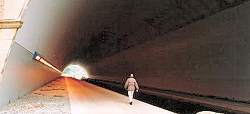 second runway has obliterated
100's of acres of farmland at the northern end of the village and replaced it
with that huge concrete strip pointing ominously right at the heart of
Knutsford - no need for concern though, this week's
Knutsford
Guardian quotes an airport spokesman as saying "Residents do not need
to worry about safety at Manchester Airport" - one day we'll remind them
about that statement (and 100's of others like it). But every cloud has a
silver lining and some interesting habitats have been created - on Tuesday we
did the circular route from Lady Lane Mobberley, round the bottom end of R2 to
Wood Lane proceeding then in a northerly direction to the Bollin, passing
through the impressive tunnel (see the picture) constructed for the river to
pass under the runway and finally back to where we started. Time for this walk
depends on the circumstances - non-stop 1½ hours, birdwatching pace
2½ hours, but 4 hours today! One of the party has accepted the challenge
to construct an online database using the
Perl programming language, this
will consist of botanical data, including images, so appropriate photos have to
be taken and accurate identification made - it's not straightforward !!! On the
bird front Willow Warblers and Chiffchaffs were both in song and a Grey Wagtail
was the only bird we've ever actually seen in the tunnel. A Common Whitethroat
became agitated by our presence close to where it had nested and during a long
encounter with a clump of Upright Hedge-parsley two Lesser Whitethroats
appeared, one was a juvenile bird and was being fed by the accompanying
adult.
second runway has obliterated
100's of acres of farmland at the northern end of the village and replaced it
with that huge concrete strip pointing ominously right at the heart of
Knutsford - no need for concern though, this week's
Knutsford
Guardian quotes an airport spokesman as saying "Residents do not need
to worry about safety at Manchester Airport" - one day we'll remind them
about that statement (and 100's of others like it). But every cloud has a
silver lining and some interesting habitats have been created - on Tuesday we
did the circular route from Lady Lane Mobberley, round the bottom end of R2 to
Wood Lane proceeding then in a northerly direction to the Bollin, passing
through the impressive tunnel (see the picture) constructed for the river to
pass under the runway and finally back to where we started. Time for this walk
depends on the circumstances - non-stop 1½ hours, birdwatching pace
2½ hours, but 4 hours today! One of the party has accepted the challenge
to construct an online database using the
Perl programming language, this
will consist of botanical data, including images, so appropriate photos have to
be taken and accurate identification made - it's not straightforward !!! On the
bird front Willow Warblers and Chiffchaffs were both in song and a Grey Wagtail
was the only bird we've ever actually seen in the tunnel. A Common Whitethroat
became agitated by our presence close to where it had nested and during a long
encounter with a clump of Upright Hedge-parsley two Lesser Whitethroats
appeared, one was a juvenile bird and was being fed by the accompanying
adult.
31/07/02 Whilst some species are declining in numbers
others are doing rather well; the Avocet is an excellent example as it steadily
extends its range and begins to gain an important foothold here in the
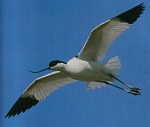 north-west of England, I think it
was last year that they were first successful in this part of the World - at
the excellent Leighton Moss RSPB Reserve. Down the coast of the Irish Sea two
more sites held breeding birds for the first time this year - Southport's
Marshside, where three young were hatched and a first for Cheshire when a pair
appeared with four youngsters on the Weaver Bend, having nested in a well
hidden spot nearby. We visited this area on Friday evening on the last of our
Summer "outdoor / indoor" walks; unfortunately we didn't come across
them on this occasion, although we subsequently found out they were still
present. Nevertheless the weather was excellent and there were plenty of other
birds to be seen - Reed and Sedge Warblers were very active in the
phragmites reedbeds, whilst on the mud of the Weaver Bend waders were much
in evidence with Ruff, Redshank, Black-tailed Godwit, Green Sandpipers and
numerous Dunlin plus a Little Gull all giving good views. Towards dusk we made
our way to the Number 5 tank where a Marsh Sandpiper had been seen - this had
moved on but we did come across a confiding Wood Sandpiper at the same
location, bringing back fond memories of Scandinavia and the Arctic
tundra.
north-west of England, I think it
was last year that they were first successful in this part of the World - at
the excellent Leighton Moss RSPB Reserve. Down the coast of the Irish Sea two
more sites held breeding birds for the first time this year - Southport's
Marshside, where three young were hatched and a first for Cheshire when a pair
appeared with four youngsters on the Weaver Bend, having nested in a well
hidden spot nearby. We visited this area on Friday evening on the last of our
Summer "outdoor / indoor" walks; unfortunately we didn't come across
them on this occasion, although we subsequently found out they were still
present. Nevertheless the weather was excellent and there were plenty of other
birds to be seen - Reed and Sedge Warblers were very active in the
phragmites reedbeds, whilst on the mud of the Weaver Bend waders were much
in evidence with Ruff, Redshank, Black-tailed Godwit, Green Sandpipers and
numerous Dunlin plus a Little Gull all giving good views. Towards dusk we made
our way to the Number 5 tank where a Marsh Sandpiper had been seen - this had
moved on but we did come across a confiding Wood Sandpiper at the same
location, bringing back fond memories of Scandinavia and the Arctic
tundra.
24/07/02 The Dipper is a bird of shallow, fast flowing streams, feeding on the larvae of aquatic insects, especially the caddis fly, which it secures when submerged, using the movement of the water over its obliquely held body in order to remain below the surface. It's not surprising then that breeding is normally confined to the east of the county, in the streams flowing through foothills of the Pennines and that, as these waters reach the flat Cheshire plain, they hold no attraction for the species as they meander slowly towards the coast . There are though exceptions and they have bred in Chelford, at Astle Pool, where a dam has been constructed to form a fishing pool, and the water flowing over the top, down the steep drop on the other side and quickly away on the outlet steam has created a suitable, artificial environment for the species. Another man made site exists in Styal around Quarry Bank Mill , a series weirs and sluices provides water to power the mill wheel and, as is the case at Chelford, man has inadvertently created a home for the Dipper. I didn't know of any records from this location until a few weeks ago when Bob Groom saw a bird there whilst on a walk from the Twinnies Bridge area of Wilmslow, they do leave the hills for lower ground, especially in bad weather, but not normally in July so it could just be a case of post-breeding dispersal by a young bird. An interesting sighting though, and worth a look again early next at the start of the breeding season.
15/07/02 Bill Mulligan
always used to take his family holidays in July contending that this was
invariably the least productive month for the birdwatcher. During the
field-work, on which the Cheshire Breeding Bird Atlas was based, we found this
not always to be the case as July was one of the best times of the year to
confirm that a species had actually bred on a particular tetrad, because during
the month it's possible to observe adults feeding their young away from the
nest.
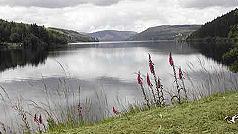 I was reminded of this on
Saturday when our July field trip took us into Wales once more - Lake Vyrnwy
our destination - the intermittent rain showers we encountered on the journey
ceased and the weather got better and better as the day progressed. We parked
next to the cafe close to the RSPB information center, enjoyed a nice cup of
coffee and availed ourselves of the facilities before heading up the hill along
the Craig Garth-Bwlch trail (the spellchecker didn't like that!). It's only a
short distance to the top of the hill and back but today it took over 2 hours,
mainly due to the interesting avian activity rather than the gradient! No
shortage of Spotted Flycatchers here, there were a number of family parties
feeding under the birches, close to the path as we made our way up the hill;
surprisingly we saw no Pied Flycatchers, perhaps they move away from the area
when the young birds fledge. Also busy feeding youngsters away from the nest,
Siskins (loads of!), Wrens, Song Thrushes, Blackbirds, Blue, Great and Coal
Tits, Willow Warblers and Chaffinches; pride of place though went to the Wood
Warblers that gave such good views, they too had families to provide for, but
still retained their distinctive plumage despite the time of year and the
amount of work they were getting through. We drove along the southern end of
the lake and had a late lunch at the far end before rounding off the day with a
trek round the Rhiwargor Trail (OK we didn't all walk this trail - Bob and I
are built for comfort not for speed!) where we had the first Ravens of the day
- a family party, perhaps, of 6 birds - and a Peregrine that circled over the
lake, before heading off over the hills towards Bala.
I was reminded of this on
Saturday when our July field trip took us into Wales once more - Lake Vyrnwy
our destination - the intermittent rain showers we encountered on the journey
ceased and the weather got better and better as the day progressed. We parked
next to the cafe close to the RSPB information center, enjoyed a nice cup of
coffee and availed ourselves of the facilities before heading up the hill along
the Craig Garth-Bwlch trail (the spellchecker didn't like that!). It's only a
short distance to the top of the hill and back but today it took over 2 hours,
mainly due to the interesting avian activity rather than the gradient! No
shortage of Spotted Flycatchers here, there were a number of family parties
feeding under the birches, close to the path as we made our way up the hill;
surprisingly we saw no Pied Flycatchers, perhaps they move away from the area
when the young birds fledge. Also busy feeding youngsters away from the nest,
Siskins (loads of!), Wrens, Song Thrushes, Blackbirds, Blue, Great and Coal
Tits, Willow Warblers and Chaffinches; pride of place though went to the Wood
Warblers that gave such good views, they too had families to provide for, but
still retained their distinctive plumage despite the time of year and the
amount of work they were getting through. We drove along the southern end of
the lake and had a late lunch at the far end before rounding off the day with a
trek round the Rhiwargor Trail (OK we didn't all walk this trail - Bob and I
are built for comfort not for speed!) where we had the first Ravens of the day
- a family party, perhaps, of 6 birds - and a Peregrine that circled over the
lake, before heading off over the hills towards Bala.
10/07/02 It was in 1995 that I last saw a Barn Owl in Cheshire, a pair had nested near Northwich and were giving good views towards dusk in rough fields close to "The Duke of Portland" in Lach Dennis. Previous to that I don't recollect any since a pair nested in the loft above the kitchen in Pavement Lane Farm, Mobberley and that must be 20 years ago. I was therefore delighted to receive an e-mail from one of our members who had recently seen a bird from her house flying over a nearby field some hours before darkness. An evening visit was quickly organised and a small group of us were rewarded by superb views of a bird hunting over the field that had been designated as "set aside" and had been allowed to "do its own thing" for the whole of this year. Groups of volunteers dedicated to reversing the Barn Owl's decline have been set up throughout the UK and their good work seems to be paying off, one local group ringed 50 birds in June - apparently with more to come! Most encouraging, they need everyone's support and well deserved congratulations.
03/07/02 Quite a journey yesterday 130 miles, up to
Bassenthwaite, for a look at the Lake District's breeding Ospreys. These birds
have returned "naturally" rather than those further south that have
been successful as part of a re-introduction scheme,
 although it must be said that the
tree being used is one of a number across the area that have been made more
"Osprey friendly" by the provision of purpose-built nesting
platforms, courtesy of The Forestry Commission. The
viewing platform is located off the A591
at Dodd Wood (NY235282) where we found 5 quality 'scopes set up for use by
visitors and an equal number of friendly, well informed Wardens who were able
to update us with the current state of play. The nest is a considerable
distance away, probably the best part of a mile, but reasonable views were
obtained through the 'scopes of both adult birds, who were now responsible for
the welfare of two chicks that hatched a couple of weeks ago, frequent forays
were made to deal with intruding Buzzards and Corvids, including
Ravens which gave excellent views when they perched close to the viewpoint.
Around lunchtime we made our way across to the nearby Whinlatter Visitor Centre
(NY208245) where live TV pictures from the nest site were being displayed;
again Wardens were on hand to answer the usual questions from the steady stream
of visitors who could afford the £2 parking fee (make hay while the sun
shines!). On the way back south we stopped at Keswick - I have never seen so
many "outdoor" shops concentrated in such a small area, all the
competition would appear to be keeping the prices to a reasonable level and I
was persuaded to part with £39.95 for a splendid new pair of walking
boots, perhaps these will make next year's ascent of Tegg's Nose a little less
painful!
although it must be said that the
tree being used is one of a number across the area that have been made more
"Osprey friendly" by the provision of purpose-built nesting
platforms, courtesy of The Forestry Commission. The
viewing platform is located off the A591
at Dodd Wood (NY235282) where we found 5 quality 'scopes set up for use by
visitors and an equal number of friendly, well informed Wardens who were able
to update us with the current state of play. The nest is a considerable
distance away, probably the best part of a mile, but reasonable views were
obtained through the 'scopes of both adult birds, who were now responsible for
the welfare of two chicks that hatched a couple of weeks ago, frequent forays
were made to deal with intruding Buzzards and Corvids, including
Ravens which gave excellent views when they perched close to the viewpoint.
Around lunchtime we made our way across to the nearby Whinlatter Visitor Centre
(NY208245) where live TV pictures from the nest site were being displayed;
again Wardens were on hand to answer the usual questions from the steady stream
of visitors who could afford the £2 parking fee (make hay while the sun
shines!). On the way back south we stopped at Keswick - I have never seen so
many "outdoor" shops concentrated in such a small area, all the
competition would appear to be keeping the prices to a reasonable level and I
was persuaded to part with £39.95 for a splendid new pair of walking
boots, perhaps these will make next year's ascent of Tegg's Nose a little less
painful!
01/07/02 We decided to forgo the comfort and convenience of the hides on our trip last week across to the excellent Woolston Eyes Reserve. We chose instead to follow the route that wends its way round the perimeter of number 4 tank, a walk of around 6 kilometers (sorry Derek - about 4 miles!) with good views from the raised path right across this part of the Reserve. The vegetation is currently in the early stages of development, mainly Nettles, Brambles and Sallow with a scattering of Alder trees, just the place for Warblers, and it was these that proved to be of most interest during the two hours it took to complete the walk. Many were still in song Common Whitethroat, Chiffchaff, Blackcap, Willow and Garden Warblers were all heard, there were no Reed Warblers, they preferphragmitesreed beds rather than this dry scrubby habitat but there were plenty of Sedge Warblers, especially on the west side of the area, and it was here we heard the distinctive sound of a singing Grasshopper Warbler, unusually it was singing from the top of a Bramble bush and gave absolutely superb views.
26/06/02 The field of newly mown hay adjacent to Pavement Lane in Mobberley has been harvested, leaving a couple of acres of cleared land that is proving to be a popular spot for feeding birds. Starlings were the most numerous this morning, there were both adults and youngsters, the latter big enough to fend for themselves but often still soliciting food from their parents. Also present were Carrion Crows, Wood Pigeons and 3 species of thrush; 2 Mistle - one adult accompanied by a juvenile, 2 Blackbirds and a pair Song Thrush collecting beak-fulls of wriggling worms that were transported across the road to their nest, well hidden in the middle of a Hawthorn hedge. About 50 yards further on came confirmation of breeding success for the Lesser Whitethroats - a bird carrying food and complaining loudly at my intrusion, no doubt attending to the needs of newly fledged young. We may be lucky and have a short period of song preceding a second brood, this has happened for the past 2 years at this spot. Interestingly BWP states that sometimes the second brood features the same male but with a new female, perhaps this brief burst of song is enough to attract a new mate. Another bit of information taken from the same source concerns the proximity of Ash trees to the nest; it appears that, during a study of this species in Leicestershire, it was found that 90% of 55 nests were constructed within a few feet of an Ash. Today's bird was actually perched in an Ash, directly across the lane from where I watched the male bird constructing a nest earlier in the year!
20/06/02 Woodlarks don't feature in my notebooks very
often, this is not just a consequence of my natural reluctance to venture too
far south of Stoke in search of birds - the species has declined markedly
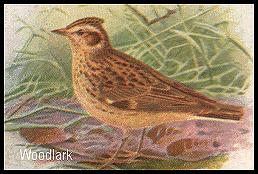 since the middle of the
nineteenth century when it was recorded as nesting in most counties of England
and Wales. This though should be treated with caution as, in some areas, the
Tree Pipit was referred to as Wood-Lark, so there may have been some confusion
between the two species. Currently they are restricted to a few areas in the
south of England with a population estimated at only 350 pairs (1988 - 91). The
preferred breeding habitat seems to depend on which book you read! although
this is possibly an indication of the species attempting to adapt as constant
changes to our countryside take place. One classic location is in open
woodland, preferably pine on sandy soil and it was in such a location within
the county of Cheshire that a Woodlark was heard singing recently! What an
exciting discovery - is this a "one off" or is there a small
population that has previously gone unrecorded?.
since the middle of the
nineteenth century when it was recorded as nesting in most counties of England
and Wales. This though should be treated with caution as, in some areas, the
Tree Pipit was referred to as Wood-Lark, so there may have been some confusion
between the two species. Currently they are restricted to a few areas in the
south of England with a population estimated at only 350 pairs (1988 - 91). The
preferred breeding habitat seems to depend on which book you read! although
this is possibly an indication of the species attempting to adapt as constant
changes to our countryside take place. One classic location is in open
woodland, preferably pine on sandy soil and it was in such a location within
the county of Cheshire that a Woodlark was heard singing recently! What an
exciting discovery - is this a "one off" or is there a small
population that has previously gone unrecorded?.
12/06/02 The Breeding Bird Atlas of Cheshire and Wirral has Meadow Pipits encountered on 32% of tetrads, with confirmed breeding on 112 (56%) of these. Most records came from the hills in the east of the County or along the Mersey and on the Wirral peninsula, there weren't many from our part of Cheshire, they are few and far between at this time of year. I was glad to hear from Jonathan Guest that he had found the species nesting at the south-western end of Manchester Airport's new runway 2 - we paid a visit to the area this evening, no luck with the pipits but plenty of other birds including many Skylarks over the huge grassed areas adjacent to the runway and good numbers of Common Whitethroats still singing from the scrubby areas next to the perimeter fence. Fewer Skylarks, but an abundance of Whitethroats across the County at the Anderton Reserve yesterday, many birds now have young; on Haydn's Pool these included Lapwings, Mute Swans, Canada Geese, Oystercatcher, Coot and Mallard, but no sign yet of breeding success for the Little Grebes although a number of adult birds were present.
30/05/02 Unable to travel with the rest of the crew to
Wales I made my way across to the Goyt Valley in search of one or two species
still missing from the (hypothetical) year list. At weekends the road through
the valley is closed to motor vehicles and it certainly makes a difference,
moving 200 yards up from the car park, the only sounds to be heard were Curlews
calling from the hilltops across the other side of the Errwood reservoir.
Plenty of activity as the woodland was reached with singing Tree Pipits, Wood
and Willow Warblers, Chiffchaff, Redstart and Pied Flycatcher, whilst on the
river below Common Sandpipers called and Grey Wagtails fed their first brood of
youngsters. The only species missing was Spotted Flycatcher but these are to be
found nearer to home, Pete Hall currently has a pair nesting at Toft.
This will be the last update of the "Latest News" for a couple of
weeks as I'm off on a family holiday to Norway, I will though be taking a pair
of binoculars enabling me to do a little birding should the opportunity arise
!
28/05/02 Thanks to Terry Atkinson for the following account of the recent Welsh Weekend.
13 members travelled to Liverpool House, Rhayader, using
different routes, highlights of the journey, Roy & Jean had Little Egret at
the Ynys-hir reserve, Derek & Jean had Crossbills at Lake Vyrnwy, Terry,
Len & John had Red Kite 7 miles from Rhayader.
After arriving at our destination at 11 15 am, we walked down the river and had
good views of Goosander, then to the crown a 16th century pub with the best
real ale in town. After meeting all the other members at the digs we all
gathered at 6 30pm for welsh beef, then out on the town finishing up at the
Crown.
Day 2 After breakfast we headed down to the Elan Valley, had a look at the dams
& reservoir which supply the water for the city of Birmingham, at the car
park we had Goosander with young, Spotted Flycatcher and a Stoat carrying food
also Greater Spotted Woodpecker. After lunch all members descended on Gigrin
farm for Red Kite feeding time, at 3 00 pm the farmer arrived on his tractor
and delivered the beef, first to arrive on the scene Crows, Jackdaws, Ravens,
Rooks, then Kites swooping down, 23 were counted with 2 Buzzards in attendance,
as we left a solitary heron sat in a tree waiting for pickings. After our
evening meal of superb tender welsh lamb, we headed for the Crown.
Day 3, We all made our way to Gilfach nature reserve which is now owned and run
by the Radnorshire wild life trust, bought in 1988. 4 walks are available, we
chose the nature trail walk, good views of the following - Whinchat, Redstart,
Pied Flycatcher, Dipper and Garden Warbler - Lenny finishing of with stunning
views of a Merlin. Some of the party took the oak wood path walk, the rest of
us went back to the Elan valley for our lunch, where we watched a Peregrine
attacking 3 Ravens. Saturday night saw us back in the Crown for our evening
meal, some members drinking about 15 bottles of aussie wine between them,
resulting in one or two bad heads and missed breakfasts the following morning,
Lenny made sure there were no empty glasses, a great end to the week end. in
total 63 species recorded, not bad considering the weather.
25/05/02 A week when the weather was dominated by a
series of low pressure fronts sweeping in from the Atlantic
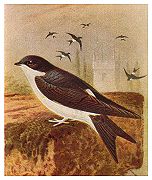 bringing unseasonable gale force
winds to the whole of the UK. House Martins were passing through still on
Thursday when the wind and rain persuaded a flock of c. 200 to spend most of
the day over the main mere at Tatton, Pete Hall reports only 6 pairs currently
nesting at Toft Hall compared with 15 last year and no less than 57 in 2000.
Newly arrived birds were collecting mud from the margins of Mobberley SQ where
5 Little Grebes have suddenly appeared - all adults and there are signs of
attempted nest building, they have little chance of success here, it may look
an attractive proposition at the moment, but within a few weeks the water will
have evapourated until the autumn rains arrive to refill it. Congratulations to
Knutsford birder Roger Barnes who was notified this week that his
Red-billed Tropic Bird record from last June
off the Scilly Islands has been accepted by the British Birds
Rarities Committee - a first for Britain !!
bringing unseasonable gale force
winds to the whole of the UK. House Martins were passing through still on
Thursday when the wind and rain persuaded a flock of c. 200 to spend most of
the day over the main mere at Tatton, Pete Hall reports only 6 pairs currently
nesting at Toft Hall compared with 15 last year and no less than 57 in 2000.
Newly arrived birds were collecting mud from the margins of Mobberley SQ where
5 Little Grebes have suddenly appeared - all adults and there are signs of
attempted nest building, they have little chance of success here, it may look
an attractive proposition at the moment, but within a few weeks the water will
have evapourated until the autumn rains arrive to refill it. Congratulations to
Knutsford birder Roger Barnes who was notified this week that his
Red-billed Tropic Bird record from last June
off the Scilly Islands has been accepted by the British Birds
Rarities Committee - a first for Britain !!
21/05/02 Friday found us on the first of the summer "outdoor/indoor" meetings, on this occasion to the Moore Nature Reserve, sandwiched between the River Mersey and the Manchester Ship Canal near Warrington. The history of the Reserve is quite complicated, but basically the area was used for dumping dredgings from the ship canal until 1988 when it was opened as a landfill site, since 1990 200 acres have been designated a nature reserve and once the landfill site is completed the whole of the 390 acre site will restored as a civic amenity. We were kindly given a tour by the Warden - Estelle Linney, accompanied by Chris Cotton her Assistant Warden, starting first at the pools on the western end of the site, a gentle stroll of about 2 kilometers. Despite the overcast conditions, there was much activity and from the phragmites reedbed came the incessant clamour of singing Reed Warblers, joined from time to time by the harsher and more varied song of Sedge Warblers. Blackcaps, Garden Warblers and even the occasional Willow Warbler sang fro the surrounding undergrowth, while on the pool itself we saw both Little and Great Crested Grebes, the latter had bred with some success judging by the four youngsters fighting for a place on the back of one of the adult birds. Making our way across to the eastern side of the Reserve we came to a splendid circular hide overlooking a marshy area, with more acrocephalus Warblers and Reed Buntings on one side and on the other a pool with Ruddy Duck, Tufted Duck and Pochard, all three breeding species. This is an excellent Reserve well worth further visits, especially as when I returned home and had a quick look on the web to check on what rarities were around it appears that on one of the pools we hadn't looked at were Little Stint, Ringed Plover, 50 Dunlin and 2 Sanderling !!
17/05/02 Summer arrived suddenly yesterday, blue skies, fluffy white clouds and a temperature of 25ºC; ideal weather for raptors and a Hobby duly obliged, spending 30' in the sky over Mobberley before vanishing over towards Tatton. In the park itself the first Sedge Warbler of the year was singing from the reeds on Knutsford moor - late, but we don't get many breeding here, only one or two at most. We had them almost three weeks ago on our canal trip in the north of the county. No Willow Warblers but the Garden Warblers are enjoying a vintage year with 4 singing males now on the moor. Normally we get the odd Wood Warbler in Dog Wood, on passage, but very occasionally remaining to breed: no sign though this year so, on Tuesday, we made our way over to Alderley Edge in search of this splendid little migrant in its local stronghold. Parking at the summit of "the Edge" next to "Beacon Cottage" we came across two singing males almost immediately, light green upper parts with yellow breast and white belly - the whole bird quivering as they sang both in flight and from the lower branches of their favourite beech trees.
13/05/02 For the past few years we've had only one pair of Garden Warblers in the small area of brambles and emergent woodland at the Dog Wood end of Tatton Park, this year we have three singing males, making it a lot more interesting for the observer. Two of the three have set up shop right next to each other and take it turns to sing from an Ash sapling that stands on the mutual border of their territories giving excellent views of both birds rather than the more usual fleeting glimpses we get when only one is present. Further into Dog Wood and looking across the mere to Higmere Plantation the Canada Goose is still incubating its eggs 40 feet up in the air in the nest used last year by Tatton's first nesting Herons - I think the word is incongruous! How does it manage to land without breaking the eggs? I once saw a Mallards nest in a similar location, and it broke more eggs every time it returned, eventually it gave it up as a bad job! Its warm and wet at the moment ideal conditions for midges and the Treecreepers and Nuthatches in Dog Wood were taking full advantage, returning to their respective nests with beaks full of insects - Nature timing things to perfection. A single Cormorant flew over the main mere, the last representative of the wintering population, whilst on the water two Goldeneyes, a young male bird and a female still lingered, perhaps content to spend the Summer with us, not yet old enough to be encouraged north by the longer days and their own increasing hormone levels.
08/05/02 There appears to have been a substantial influx of migrants during the past few days, in Mobberley Lesser Whitethroats were rattling away from thick undergrowth at two new locations early this morning, joining a third bird we heard in the Fox Harbour area on Monday. On first arrival these male birds range over a wide area, singing and building trial nests, one of which will (hopefully) be found acceptable by a female. Over at the Anderton Reserve near Northwich a visit yesterday (7th) produced more warblers, especially Common Whitethroats, Chiffchaffs, Sedge and Reed Warblers; Willow Warblers though still remain thin on the ground. Across the other side of the tracks on Clamhunger Lane, having finished his domestic duties, Derek Pike witnessed a bit of a drama when he came across a female Sparrowhawk pinned down in the middle of the road by an irate Carrion Crow who appeared to have lost a youngster to the hawk. It reminded me of the time I watched a vicious fight between a Hedgehog and a rat - the hedgehog won on points !!
03/05/02 Unsettled weather for most of this week although things seem to be settling down for the coming holiday weekend. Monday (29th) was the worst day with a ferocious westerly gale coming in from the Irish Sea; no problem though for those most seasoned of travellers, the Arctic Terns, 5 were hawking for insects low over Tatton Mere, part of large influx that day throughout the UK. 6 were noted at Budworth at the same time as we were watching the Tatton birds, only one of these 6 remained the following day when we visited that particular location. The Lesser Spotted Woodpeckers were giving good views from Marbury Lane, now smelling like the dustbin of an Indian take-away with the "scent" from the flowering Ramsons! From the hide overlooking Haydn's pool our first Yellow Wagtail of the year was darting about the muddy margins, in and out of the juncus reeds, this species is now considered scarce enough to appear on the pagers, it wasn't so long ago that me and "the boy Armit" had 50 individuals fly out of the Alder at the bathing area in Tatton! The bird of the day was a splendid male Whinchat perched on the fence wires near the Northwich car park, we don't see many of these at this time of year and its plumage was incredible - in such good light it appeared to have been painted on!
28/04/02 An interesting second half of last week provided more new birds for the year. On Wednesday (24th) the rattling song of a Lesser Whitethroat revealed its presence early in the morning from the depths of an overgrown hawthorn hedge in Lady Lane, Mobberley just where it reaches the Airport perimeter fence. Across the village, in Pavement Lane, the first Common Whitethroat was watched the following morning as we made our way to Warrington for a rendezvous with "The Thursday Group" who had kindly invited us to join them for the day on a hired narrow boat for a cruise from Preston Brook to Grappenhall and back! An account of this epic voyage is available on Rear Admiral Sir John Somerville's website! The canal-side wildlife has become accustomed to boats passing back and forth all day and we were able to obtain excellent views of Mute Swans, Coots and Moorhens on their nests, Sedge Warblers sang from the phragmites reed beds as we glided slowly passed and on two occasions Common Sandpipers were seen on the side of the canal - they allowed us to get about 10 yards from them before they flew on, low over the water with that characteristic intermittent flight that make them so easy to identify. The dry weather has definitely gone for the time being and strong north-westerlies are holding up the hirrundines on their way north, joining them on Saturday (27th.) the first Swifts - no less than 16 over Tatton mere.
 23/04/02
Summer migrants continue to appear at regular intervals and slightly earlier
than average. Two birders from Northwich kindly sent an e-mail with news of
Tatton's first Garden Warbler of the year - a bird singing on Knutsford Moor on
Sunday (24th), it was still there the following morning, the average date for
this species is 4th. May. Also early the Cuckoo
calling yesterday evening in the Dog Wood / Knutsford Moor area, just a day
earlier than one of its favourite hosts - the Reed Warbler - one was singing from the
Phragmites on the Moor tonight, following a bird heard this morning at
Haydn's pool on the Anderton Reserve at Northwich.
23/04/02
Summer migrants continue to appear at regular intervals and slightly earlier
than average. Two birders from Northwich kindly sent an e-mail with news of
Tatton's first Garden Warbler of the year - a bird singing on Knutsford Moor on
Sunday (24th), it was still there the following morning, the average date for
this species is 4th. May. Also early the Cuckoo
calling yesterday evening in the Dog Wood / Knutsford Moor area, just a day
earlier than one of its favourite hosts - the Reed Warbler - one was singing from the
Phragmites on the Moor tonight, following a bird heard this morning at
Haydn's pool on the Anderton Reserve at Northwich.
20/04/02 The dry spell of weather ended on Wednesday evening (17th) with a sustained period of much needed rain, the following morning the first Willow Warblers were singing in Tatton, one in Dog Wood and a second in Higmere Plantation. A Water Rail called non-stop from the reeds on Knutsford Moor, not its proper "song" but an encouraging sign given the time of year; over the main mere my first 2 House Martins, although they have been around for sometime, Terry Atkinson had 4 a week earlier (11th). The warmer weather on Friday generated some thermals and in one of these a local observer counted 4 Buzzards, 2 Sparrowhawks and the year's first Hobby!!
14/04/02 Saturday found us once again crossing the border
into Wales on our way to another "new" venue, this time the
destination was World's End between Wrexham and Llangollen, an upland area of
moorland with nearby hills rising to over 1700'.
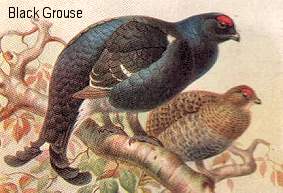 We were
assured by our Chairperson that this was the location for Black Grouse
and other visiting groups had all managed to obtain good views of this
increasingly rare species (how many times have we heard that before?!). No
problems this time though, after a short, smooth flight from Knutsford Captain
Somerville guided the Mondeo safely down into the car park where we were able
to set up the 'scopes prior to the arrival of the rest of the party and
immediately locate a splendid male Black Grouse showing well, in excellent
light, as it moved through the bracken on an adjacent hillside. Leaving the car
park we made our way onto the moorland and set off on a 3 mile circular walk
that should have taken a couple of hours but actually lasted more than three as
we thought it judicious at one stage not to proceed down a steep difficult path
towards the end of the walk, but to return the way we had come. The weather was
superb throughout and it was a good job too, we agreed that World's End was a
"fair weather" venue and would prove very unrewarding on a wet day.
Around the car park area Dunnocks, Wrens, Chaffinches,
We were
assured by our Chairperson that this was the location for Black Grouse
and other visiting groups had all managed to obtain good views of this
increasingly rare species (how many times have we heard that before?!). No
problems this time though, after a short, smooth flight from Knutsford Captain
Somerville guided the Mondeo safely down into the car park where we were able
to set up the 'scopes prior to the arrival of the rest of the party and
immediately locate a splendid male Black Grouse showing well, in excellent
light, as it moved through the bracken on an adjacent hillside. Leaving the car
park we made our way onto the moorland and set off on a 3 mile circular walk
that should have taken a couple of hours but actually lasted more than three as
we thought it judicious at one stage not to proceed down a steep difficult path
towards the end of the walk, but to return the way we had come. The weather was
superb throughout and it was a good job too, we agreed that World's End was a
"fair weather" venue and would prove very unrewarding on a wet day.
Around the car park area Dunnocks, Wrens, Chaffinches,
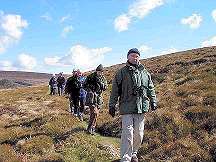 Mistle
Thrushes and a single Willow Warbler were noted; as we climbed onto the
moorland the number of birds decreased, except of course for the ubiquitous
Meadow Pipits - they were everywhere! Ravens were quite numerous but it was the
raptors that proved of most interest, single Sparrow Hawks, Kestrels and a
Peregrine made their appearances, but for a long time no Buzzards were seen,
eventually 6 appeared and gave us memorable views as they glided round us,
floating effortlessly on the wind currents generated by a strong easterly
swirling through the hills. Buzzards have very variable plumages, nevertheless
one of these individuals stood out as being very different, it had a
rufous coloured tail, the same as seen on a Red KIte and as it flew very close
to us it was possible to see and hear bells attached to its legs, one of the
more travelled members of the party identified it as an American Red-tailed
Hawk (Buteo jamaicensis); what a pleasure to see such a splendid bird in
its true environment rather than being worn like a piece of jewelry on
someone's wrist at the Cheshire Show or some other country fair. I have no
problem with falconry, but doubt that this bird would return home of its own
volition!
Mistle
Thrushes and a single Willow Warbler were noted; as we climbed onto the
moorland the number of birds decreased, except of course for the ubiquitous
Meadow Pipits - they were everywhere! Ravens were quite numerous but it was the
raptors that proved of most interest, single Sparrow Hawks, Kestrels and a
Peregrine made their appearances, but for a long time no Buzzards were seen,
eventually 6 appeared and gave us memorable views as they glided round us,
floating effortlessly on the wind currents generated by a strong easterly
swirling through the hills. Buzzards have very variable plumages, nevertheless
one of these individuals stood out as being very different, it had a
rufous coloured tail, the same as seen on a Red KIte and as it flew very close
to us it was possible to see and hear bells attached to its legs, one of the
more travelled members of the party identified it as an American Red-tailed
Hawk (Buteo jamaicensis); what a pleasure to see such a splendid bird in
its true environment rather than being worn like a piece of jewelry on
someone's wrist at the Cheshire Show or some other country fair. I have no
problem with falconry, but doubt that this bird would return home of its own
volition!
11/04/02 Plenty of singing Warblers during a walk round the Anderton Reserve on Tuesday (9th) we counted 6 Willow Warblers, 5 Blackcaps and 5 Chiffchaffs. Haydyn's Pool held teal, Great Crested and Little Grebes and 3 pairs of Gadwall, 2 pairs of Lapwings appeared to have selected the large island as a nest site and were preparing scrapes in preparation for egg laying. Orange Tipped and Peacock butterflies were both on the wing taking full advantage of yet another cloudless Spring morning that are becoming such a feature of the weather so far this year . Great Spotted and Green Woodpeckerswere picked up easily during the first half of the walk but the Lesser Spotted proved a little more elusive, despite being given detailed instructions on where to find them by a couple of the local birders. Eventually though a male bird revealed its presence as it drummed loudly on a dead branch at the top of an oak tree, and loud it was, initially we took it for a Great Spotted such was the racket it was creating! Despite the fine weather there are still some Winter birds around, a Brambling called from the upper boughs of a Beech tree in Tatton's Dog Wood, they'll be around until the beginning of May but will become increasingly difficult to see as the leaves appear - learn the call!!! More unusual was a flock of 9 Fieldfares at Barclay Hall in Mobberley today (11th.), they've normally left for the north well before now.
08/04/02 No new migrant species so far this week in Tatton, although the Crossbills first seen a couple of weeks ago reappeared on Sunday, when Andy Whitby had two birds, a male and female, in the conifers alongside the main mere. More were present last week in Toft where Pete Hall recorded 7 birds, 2 males and 5 females, it was this time of the year in 2000 that the flock of 11 Crossbills first appeared over towards the Deer Park beyond Tatton's Old Hall. Pete heard a Willow Warbler in song last week also in Toft, we've not had any yet in Tatton although it's still relatively early, the average arrival date in the Knutsford Moor / Dog Wood area being the 12th of April. The long staying Black-necked Grebe on the main Mere had been joined by a second bird on Sunday, we didn't see them this morning so perhaps they've moved on or even secreted themselves away on Knutsford Moor with a view to giving us a new breeding species!
02/04/02 Appetites whetted by Tatton's Black-necked Grebes the Tuesday group, "The coffin dodgers", complete with a set of new permits made the short journey across to the Woolston Eyes Reserve on the outskirts of Warrington in search of further views. Around 35 birds were present and from the hides, despite the rather gloomy weather, we watched as groups of birds in a constant state of flux fought and bickered as pair formation took place. Some relationships though seemed to be well established and these pairs were indulging in their complex courtship displays, breaking off frequently to allow the male bird (presumably) to chase off an unpaired rival. Only a single Gadwall was seen but plenty of Pochard were present, this seems to be their local stronghold; last year 15 to 20 pairs were estimated. An early Willow Warbler sang from the undergrowth as we approached one of the hides, it's to be hoped they have recovered from last year's slump - perhaps the foot and mouth epidemic interfered with survey work, but around the Knutsford area we thought there had been a 60% reduction in numbers. Back at Tatton, towards dusk the pre-roost flock of hirrundines numbered about 120 individuals, including at least 2 Swallows, our first of the year 11 days later than the previous 2 years but only 2 days past the 15 year rolling average.
28/03/02 The Grebes didn't hang about, by noon the next day they'd moved on, probably to Woolston where 20+ birds are now displaying. No further arrivals in Tatton but across at Toft Pete Hall had a singing Blackcap on the 27th and the previous day an early Swallow back at the farm, birds are normally seen over the Meres before they arrive back at their actual nesting sites so this was quite an unusual event.
25/03/02 A disappointing start to
today's stroll round Tatton Park, now back to Summer opening times, 08:00 to
19:00 7 days a week. The Herons that appeared intent on nesting again in
Higmere Plantation
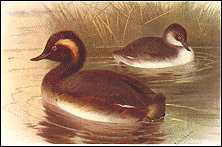 across from Dog Wood
have not been seen for a couple of days and may have moved elsewhere. A loud
raucous call drew our attention to a lone Greylag Goose floating in the center
of the main mere that perhaps realised it should be heading north and was
looking for some company on its journey. Two Great Crested Grebes were busy
displaying at the Knutsford Moor end of the main mere, but of much more
interest were 3 smaller Grebes in the shallow water adjacent to Dog Wood, they
were Summer plumaged Black-necked Grebes, splendid little creatures that didn't
breed in England until 1915, but over the past decade have established a
foothold locally at the Woolston Eyes Reserve near
Warrington where more than 20 young were raised last year. Looking at the
latest available Cheshire Bird Report (2000) the first bird of the year
returned to the Reserve on the 15th of March and by the end of the month 17
were present, so it's probable Woolston will be the final destination for these
birds. Initially they were feeding from the surface on emerging insects, but
soon moved further out taking long dives of 20" or more in search of
sustenance, eventually the 3 original birds were joined by 3 more and the 6
gave super views only yards from the concrete boat launching jetty, it would be
nice if a couple stayed on, it's doubtful but you never know! At the same time
as we were watching the Grebes it was evident that a considerable build-up of
Sand Martins was taking place, in fact there were so many that they had reached
the guesstimate level - between 150 and 200, two weeks to the day after the
first record for this year.
across from Dog Wood
have not been seen for a couple of days and may have moved elsewhere. A loud
raucous call drew our attention to a lone Greylag Goose floating in the center
of the main mere that perhaps realised it should be heading north and was
looking for some company on its journey. Two Great Crested Grebes were busy
displaying at the Knutsford Moor end of the main mere, but of much more
interest were 3 smaller Grebes in the shallow water adjacent to Dog Wood, they
were Summer plumaged Black-necked Grebes, splendid little creatures that didn't
breed in England until 1915, but over the past decade have established a
foothold locally at the Woolston Eyes Reserve near
Warrington where more than 20 young were raised last year. Looking at the
latest available Cheshire Bird Report (2000) the first bird of the year
returned to the Reserve on the 15th of March and by the end of the month 17
were present, so it's probable Woolston will be the final destination for these
birds. Initially they were feeding from the surface on emerging insects, but
soon moved further out taking long dives of 20" or more in search of
sustenance, eventually the 3 original birds were joined by 3 more and the 6
gave super views only yards from the concrete boat launching jetty, it would be
nice if a couple stayed on, it's doubtful but you never know! At the same time
as we were watching the Grebes it was evident that a considerable build-up of
Sand Martins was taking place, in fact there were so many that they had reached
the guesstimate level - between 150 and 200, two weeks to the day after the
first record for this year.
17/03/02 An excellent turnout for today's trip to the
Seaforth Reserve right in the middle of Liverpool's docklands; we'd booked in
for this visit some months ago and were the only visitors due to very
restricted access at the moment because of imminent construction work which
will see the rough ground adjacent to the information
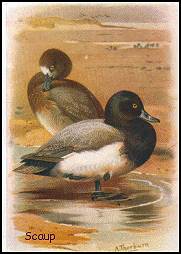 center taken over by new
warehousing. Luckily the owners, the Mersey Docks and Harbour Board, are very
sympathetic to the needs of the birds and Steve White the chief warden and his
colleagues have persuaded them to excavate two new pools, complete with with a
reed bed, rain water from the roof of the new warehouse will run off into these
new areas of water. Plenty of activity today during our visit with numerous
Black and at least one Bar-tailed Godwit, Curlew, Redshank and displaying
Ringed Plovers plus the Reserve's first three Wheatears of the year. The
highlight for us though were the ducks, 26 Goldeneye were accompanied by a
splendid flock of 49 immaculate Scaup, a bird we rarely see in our part of
Cheshire and certainly not with such excellent views as we enjoyed today. We
left Seaforth at around noon and made our way across to Frodsham Marshes where
we lunched overlooking the Weaver Bend, where weekend sailors tacked back and
forth across the river, I hope they didn't go overboard into that water, unless
there's been a dramatic improvement over the past couple of years in the water
quality, such an event would demand an immediate shower and stomach pump!
Quality birds aplenty around the No.6 tank With 100+ Shoveler, more
Black-tailed Godwits, a Merlin, 7 Ruff, flocks of Dunlin, 6 Little Stints and a
fine Lesser Yellowlegs that gave good views both in the tank and as it flew off
towards the nearby Manchester Ship Canal. Back home in Knutsford a Chiffchaff
was singing in Shaw Heath garden and a Lesser Spotted Woodpecker was heard
calling in Dog Wood, no sign of it today though, but Tatton's first returning
Chiffchaff was heard in song and 23 Sand Martins were hawking for insects over
the main mere.
center taken over by new
warehousing. Luckily the owners, the Mersey Docks and Harbour Board, are very
sympathetic to the needs of the birds and Steve White the chief warden and his
colleagues have persuaded them to excavate two new pools, complete with with a
reed bed, rain water from the roof of the new warehouse will run off into these
new areas of water. Plenty of activity today during our visit with numerous
Black and at least one Bar-tailed Godwit, Curlew, Redshank and displaying
Ringed Plovers plus the Reserve's first three Wheatears of the year. The
highlight for us though were the ducks, 26 Goldeneye were accompanied by a
splendid flock of 49 immaculate Scaup, a bird we rarely see in our part of
Cheshire and certainly not with such excellent views as we enjoyed today. We
left Seaforth at around noon and made our way across to Frodsham Marshes where
we lunched overlooking the Weaver Bend, where weekend sailors tacked back and
forth across the river, I hope they didn't go overboard into that water, unless
there's been a dramatic improvement over the past couple of years in the water
quality, such an event would demand an immediate shower and stomach pump!
Quality birds aplenty around the No.6 tank With 100+ Shoveler, more
Black-tailed Godwits, a Merlin, 7 Ruff, flocks of Dunlin, 6 Little Stints and a
fine Lesser Yellowlegs that gave good views both in the tank and as it flew off
towards the nearby Manchester Ship Canal. Back home in Knutsford a Chiffchaff
was singing in Shaw Heath garden and a Lesser Spotted Woodpecker was heard
calling in Dog Wood, no sign of it today though, but Tatton's first returning
Chiffchaff was heard in song and 23 Sand Martins were hawking for insects over
the main mere.
13/02/02 Hot on the heels of Monday's first returning Summer migrant comes news from Toft of the second, a Chiffchaff heard singing today by Pete Hall. Pete also reports a drumming Lesser Spotted Woodpecker on Toft Hall Farm, this is the best time of year to try and locate this increasingly rare species; a call similar to the Great Spotted Woodpecker, but thinner and less far-reaching often revealing their presence. On Tuesday we had all three Woodpeckers on a circular walk round the Anderton Reserve near Northwich, the Lesser Spotted was in a small roadside copse behind the hide at Haydyn's Pool. There's much activity at the moment on the Reserve, the refurbishment of the Anderton Lift is complete and it will be re-opened at a lavish ceremony on the 22nd. - by whom, is being kept secret, but a lot of cash is being spent and the smart money is going on HRH Prince Charles.
11/03/01 Congratulations to Jill Thornley the winner of this year's KOS Sand Martin competition, her estimate of 10am on the 11th being only 40 minutes out! Commiserations to Sue Grassby, Peter Marshall and Derek Pike who also all got the correct date, but it was Jill's time that was actually closest, perhaps next year we might award a consolation prize! Birds have been reported all this week from the south of England but adverse conditions seem to have hampered them on their journey north, today's bird arrived in the middle of a vicious hailstorm backed up by a gale force wind that was sweeping across the main mere - Spring at last, get those shorts on and dig out the sun lotion!
| 1989 | 8th. March |
| 1990 | 13th. March |
| 1991 | 13th. March |
| 1992 | 14th. March |
| 1993 | 13th. March |
| 1994 | 12th. March |
| 1995 | 11th. March |
| 1996 | 20th. March |
| 1997 | 11th. March |
| 1998 | 19th. March |
| 1999 | 13th. March |
| 2000 | 10th. March |
| 2001 | 9th March |
| 2002 | 11th March |
02/03/01 Many thanks to all those who entered this year's Sand Martin competition, a record breaking 48 this time, with entries from as far away as Reykjavik and The People's Democratic Republic of Toft! Most estimates ( I hesitate to use the word guesses!) are grouped around next weekend with the favourites being the 8th (9) and 12th (8). It's not hirrundine weather at the moment with sub-zero temperatures at night and cool and cloudy conditions during the day, nevertheless things are on the move with plenty of Meadow Pipits in Tatton and at the Anderton Nature Reserve (Northwich) when we paid a mid-week visit. Also in Tatton in the mereside reeds and surrounding birches the annual re-appearance of migrating Reed Buntings, the first Sand Martins normally following within two weeks. Alongside Pavement Lane in Mobberley one of the most evocative of early Spring's many and varied sounds, that of the Lapwing; around a dozen birds calling loudly as they indulged in lengthy aerial chases whilst deciding who nests where on their favourite fields.
21/02/02 There's never too much time for birding when out with the Thursday Group who's raison d'être is cardiovascular rather than ornithological, luckily there were no hills involved on today's outing as a poor weather forecast had persuaded them to desert the hills for the flatlands of Tatton. We enjoyed a brisk 7 mile journey round the perimeter of the Park on a cool but mainly dry morning with little in the way of song, except for the Thrush family with both Song and Mistle in fine voice. A large mixed flock of Starlings, Fieldfares and Redwings fed in a field at the far end of the mere overlooking the deer park; earlier, in Mobberley a flock of c.50 Redwings perched in a tight group in a roadside oak had been heard in their typical late winter sub-song - a quite almost conversational babble indulged in by all members of the party - as if they were discussing whether or not they should be heading north. Highlight of the morning was an exhibition being held in the grounds of Tatton Hall; called Onetree it's the final outcome of a project that aimed to show the unique value of our woodlands by showing the volume and quality of work that can be made from one tree. The tree chosen was one of Tatton's oaks that was removed from the car park wood in November 1998 and the range of objects produced by the craftsmen and women who were chosen to participate is quite remarkable, ranging from ladies dresses to a drinks cabinet priced (allegedly) at £250,000!! Entrance is free and the exhibition runs until 1st March 2002.
14/02/02 The KOS has a full calendar of field trips with outings every month of the year including the Summer when the Friday indoor meetings are replaced by a series of evening walks in or around the Knutsford area. We always try to include a few new venues each year, Sunday found us on one such trip - to the Deeside Naturalists' Society's reserve at Connah's Quay just over the Welsh border on the banks of the River Dee just as it opens out into the estuary. The Reserve has been established in the grounds of the new gas power station and from the main hide superb views were obtained right across the estuary to Inner Marsh Farm, Parkgate and out to Hilbre Island. Flocks of waders were sitting out the high tide, 100's of Black-tailed Godwits, Lapwings and Dunlin, plus an early Greenshank were watched in excellent light. Across the Reserve we had our lunch in the splendid new information center before moving inland a little, Twite had been seen earlier but we only managed a flock of 22 Linnets and a lone female Reed Bunting, they scattered in all directions at one stage as a Peregrine Falcon passed overhead. The Peregrines are resident on the reserve, nesting on the Gas Plant close to the pylons that Ravens use as nesting platforms! Back in Mobberley the first Chaffinch spluttered into song on Monday (11th.) being joined by a second bird the next day and by Wednesday they could be heard right across the county.
08/02/02 The inexorable change of seasons continues, only
slowly at present but in a months time we'll hope to have the first
Sand Martins back and from then on things will
really start to accelerate.
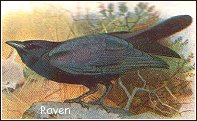 In Mobberley a few Greenfinches
have returned to the well-stocked village gardens where they will spend the
Spring and Summer, nesting mainly in conifers from late April onwards. Across
in Northwich we parked at the Anderton Lift car park and walked a circular
route to Neumann's Flash and back via Haydn's Pool and the Trent & Mersey
canal towpath, a few Little Grebes had returned to Haydn's Pool where the usual
Snipe had been joined by a Black-tailed Godwit. A massive flock of waders was
circling over Neumann's Flash as we approached, c 1200 Lapwings and c 200
Golden Plovers; something had put them up, perhaps one of the Peregrines from
the ICI works at Lostock Gralam (a pair nested on one of the chemical plants
last year, raising four young). A deep, croaking call drew our attention to an
overflying Raven, one of a pair apparently, hopefully they are following in the
footsteps of the Buzzards and are re-establishing themselves on the Cheshire
plain after being forced out during the 19th and early 20th Centuries by
shooting interests.
In Mobberley a few Greenfinches
have returned to the well-stocked village gardens where they will spend the
Spring and Summer, nesting mainly in conifers from late April onwards. Across
in Northwich we parked at the Anderton Lift car park and walked a circular
route to Neumann's Flash and back via Haydn's Pool and the Trent & Mersey
canal towpath, a few Little Grebes had returned to Haydn's Pool where the usual
Snipe had been joined by a Black-tailed Godwit. A massive flock of waders was
circling over Neumann's Flash as we approached, c 1200 Lapwings and c 200
Golden Plovers; something had put them up, perhaps one of the Peregrines from
the ICI works at Lostock Gralam (a pair nested on one of the chemical plants
last year, raising four young). A deep, croaking call drew our attention to an
overflying Raven, one of a pair apparently, hopefully they are following in the
footsteps of the Buzzards and are re-establishing themselves on the Cheshire
plain after being forced out during the 19th and early 20th Centuries by
shooting interests.
31/01/02 Not too much to report from Tatton, it's become a little like the trophy room at Maine Road over the past couple of weeks. The Canada Geese on Knutsford Moor are beginning to pair off and they're at that very noisy stage as they struggle amongst themselves to establish and defend nesting territories, no doubt they will be redefined if last year's pair of Mute Swans reappear and set up shop again. Some song in Dog Wood where a lone Great Spotted Woodpecker was drumming half - heartedly, it turned out to be a female bird. Further up the mere the female Stonechat that has remained in the Park over the Winter was again frequenting the single small alder tree at the old bathing area, it has been seen in the company of the male bird, but on this occasion it was again on its own. As we headed back out of Dog Wood A pretty disappointing morning was enlivened by the appearance of a massive flock of Pink-footed Geese heading in a north-westerly direction, towards the Lancashire mosses no doubt. I estimated around 600 birds were involved and represented the biggest single flock I've ever seen over Cheshire. They had passed over Mobberley, about 2 Kilometers from the end of Runway2 at Manchester airport, from where only a couple of minutes earlier a PIA 747 has clawed its way into the air. I presume a flock this size would have shown up on the airport's radar and appropriate action taken, because a Jumbo jet hitting such a large group of birds could have ended up in real trouble.
23/01/02 Despite the hard weather on the European mainland we haven't seen much in the way of cold weather bird movement in this part of the UK, only average numbers of winter thrushes and no Waxwings, Crossbills or big flocks of Lapwings etc. making their way westwards towards Ireland and the milder conditions normally found there when the rest of the British Isles struggle with sub-zero temperatures. A welcome exception are the Bitterns that have appeared across the length and breadth England (and it seems to be only England where the influx is taking place, there have been no reports from elsewhere) - three birds were discovered at the new London Wetlands Center, an event that received wide coverage in the media, even as far as TOGmeisterTerry Wogan on Radio 2, who was asking his listeners for suggestions as to what should be served alongside roast Bittern!! Closer to home two birds are present at Rostherne and three in the Coward memorial reed bed at Budworth Mere. We had a trip over to Budworth, stopping along the way at Dark Lane, Higher Marston where we finally got to grips with the long staying Great White Egret (Egretta alba) that had arrived some weeks ago via Sandbatch and seems quite content with its new home alongside a small stream leading over the fields towards Pickmere Lake. Unfortunately we dipped on the Bitterns but it was a pleasant day and the feeders in front of the viewing screen overlooking the reedbed were doing a roaring trade with a procession of Blue, Great and Coal Tits together with one or two increasingly vocal Nuthatches. Above us in the trees a Lesser Spotted Woodpecker called briefly, but we were unable to locate its exact position and get a view of this increasingly rare little chap - perhaps next time!
15/01/02 Nice to see everyone again after the Christmas break ready for the first KOS field trip of the year - a morning walk round Tatton, starting and ending at the Dog Lodge lay-by. Slow going on a dull, cloudy morning, a straw poll revealing more than 50% of the participants back on a diet after the Christmas excesses! The ice cover of last week on the Moor and Tatton and Melchett Meres had disappeared along with the Water Rails forced out of the reed bed during the recent cold spell, Kingfishers had reappeared with the return of the open water and two gave momentary views as we approached the Moor. Dog Wood was quiet although Wrens, Robins, Great and Blue Tits were all in song and we had excellent views of two Treecreepers as they searched, perhaps for a possible nest site, behind sheets of rotting bark at the top of one of Dog Wood's Oak trees, there's no shortage of suitable locations here. Tatton's main mere was very quiet, single figure counts of Tufted Ducks and Pochards but about 15 Goldeneyes including some fine male birds, not displaying yet - the mild weather doesn't fool them! More of interest on Melchett including a female Goosander and eight Wigeon whilst three Buzzards appeared from over the trees as we stood overlooking the Mill Pool at the far end of the park. Here also a large mixed flock of Starlings, Fieldfares and Redwings foraged on the open ground over towards the War Memorial, an area that had been used to isolate the Deer during the foot-and-mouth crisis, speaking of which - today the UK is now officially free of the disease, 11 months after its first appearance last February. We all hope lessons have been learnt!
07/01/02 Our friends across the North Sea in mainland Europe always seem to enjoy their winters more than we do in Britain, and it's easy to understand why after experiencing three weeks of "continental" weather ourselves over Christmas and the New Year. A persistent area of high pressure hovered over the British Isles giving us clear, freezing nights followed by blue skies and sunshine the next day with the mercury reluctant to creep above freezing point. Tatton Mere froze over completely, although not enough to bear the weight of skaters as was the case in the 1980's when we were able to walk across the ice from one side to another. Melchett Mere always retained a small area of unfrozen water where we noted 100's Mallard stood around on the ice whilst on the water itself the constant movement of a mixed flock of Tufted Ducks, Pochard, Teal and Goldeneye helped prevent it freezing over completely. Knutsford Moor was solid with ice except for the usual channel from the spring near the pumping station into the main mere. Flocks of Siskins and a few Redpolls bathed in the running water near where it appeared from underground, and the usual Water Rails fed along the channel as it meandered along through Dog Wood. I've mentioned this spring before, it never seems to freeze, no matter how cold the weather so I took along a calibrated thermometer and measured a few temperatures. The air temperature was 0ºC but the temperature of the water coming from underground was 9ºC falling to 4ºC as it flowed into Tatton Mere. A drain coming off a nearby field, close to the surface gave a reading of 6ºC, so the difference of 3ºC must be due to the increased depth from which the spring on the moor originates.
31/12/01 The cold, settled spell of weather has continued
over the Christmas holiday period with a minimum last night of -6ºC.
Surprisingly there seems to have been little in the way of any cold-weather
movement of birds. Pete Hall had a large flock of 1200 Fieldfares,500 Starlings
and 200 Redwings in Toft but that was
 almost three weeks ago and today
in Tatton no large concentrations were seen, just isolated Redwings in Dog Wood
grubbing amongst the leaf litter in the company of Blackbirds and Song
Thrushes. Things were also quiet for the annual Christmas walk around Great
Budworth, a figure-of-eight route of about 4½ miles, starting and ending
at the Anderton Lift car park, via Haydn's Pool and Budworth Mere. Highlight
was perhaps the small flock of Lesser Redpolls that gave close views as they
fed just above our heads in a roadside Silver Birch. At Budworth Mere the
viewing screen overlooking the feeding station has been completed and gives
good views of birds using the tables and hanging baskets, I believe this is a
good spot for Lesser Spotted Woodpecker but we saw none on our visit, perhaps
the approach path could be screened from view as the birds can see visitors
walking to the screen - which in some ways defeats its purpose! The annual KOS
Christmas party took place this year on a Thursday for the first time and
attracted a good turnout of members, the food was well up to the standard we
have come to expect, it was excellent (especially of course the baked spuds!) -
and still only £4.50 a head! Together with Roy's bring and buy activities
a profit of £100 was made on the evening, enough to pay for a couple of
Speakers in the coming year! A Happy New Year and good birding from the
KOS!
almost three weeks ago and today
in Tatton no large concentrations were seen, just isolated Redwings in Dog Wood
grubbing amongst the leaf litter in the company of Blackbirds and Song
Thrushes. Things were also quiet for the annual Christmas walk around Great
Budworth, a figure-of-eight route of about 4½ miles, starting and ending
at the Anderton Lift car park, via Haydn's Pool and Budworth Mere. Highlight
was perhaps the small flock of Lesser Redpolls that gave close views as they
fed just above our heads in a roadside Silver Birch. At Budworth Mere the
viewing screen overlooking the feeding station has been completed and gives
good views of birds using the tables and hanging baskets, I believe this is a
good spot for Lesser Spotted Woodpecker but we saw none on our visit, perhaps
the approach path could be screened from view as the birds can see visitors
walking to the screen - which in some ways defeats its purpose! The annual KOS
Christmas party took place this year on a Thursday for the first time and
attracted a good turnout of members, the food was well up to the standard we
have come to expect, it was excellent (especially of course the baked spuds!) -
and still only £4.50 a head! Together with Roy's bring and buy activities
a profit of £100 was made on the evening, enough to pay for a couple of
Speakers in the coming year! A Happy New Year and good birding from the
KOS!
21/12/01 During the Spring, because of the foot-and-mouth
restrictions, one important ornithological event that went unnoticed was the
nesting of a pair of Herons in Tatton Park for the first time.
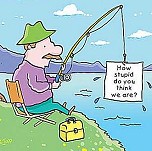 The nest was constructed in
Higmere Plantation close to the top of one of the waterside alder trees
opposite Dog Wood and was viewable only from there, by the time the
restrictions were lifted any young birds that had been reared were gone, but
judging by the appearance of the nest and its surroundings it's entirely
possible that the attempt was successful. Herons are early nesters and a full
clutch of eggs will sometimes have been laid by the middle of February so
activity around the nest site begins around this time of year and earlier this
week a bird had taken up residence in the nest tree, presumably in early
preparation for the coming breeding season. Herons nest in colonies so this
first pair may eventually be joined by others, perhaps an overflow from the
eighty strong colony in Tabley Park a couple of miles to the south-west.
The nest was constructed in
Higmere Plantation close to the top of one of the waterside alder trees
opposite Dog Wood and was viewable only from there, by the time the
restrictions were lifted any young birds that had been reared were gone, but
judging by the appearance of the nest and its surroundings it's entirely
possible that the attempt was successful. Herons are early nesters and a full
clutch of eggs will sometimes have been laid by the middle of February so
activity around the nest site begins around this time of year and earlier this
week a bird had taken up residence in the nest tree, presumably in early
preparation for the coming breeding season. Herons nest in colonies so this
first pair may eventually be joined by others, perhaps an overflow from the
eighty strong colony in Tabley Park a couple of miles to the south-west.